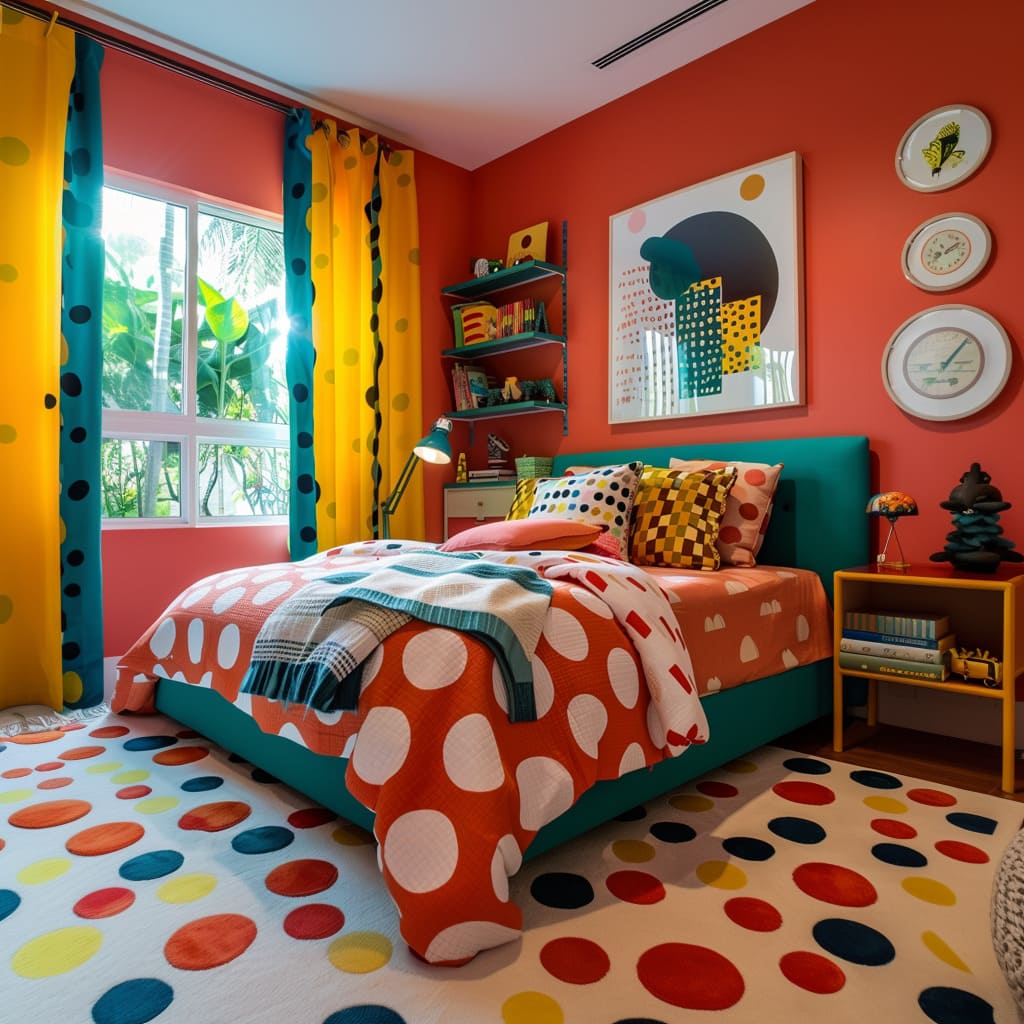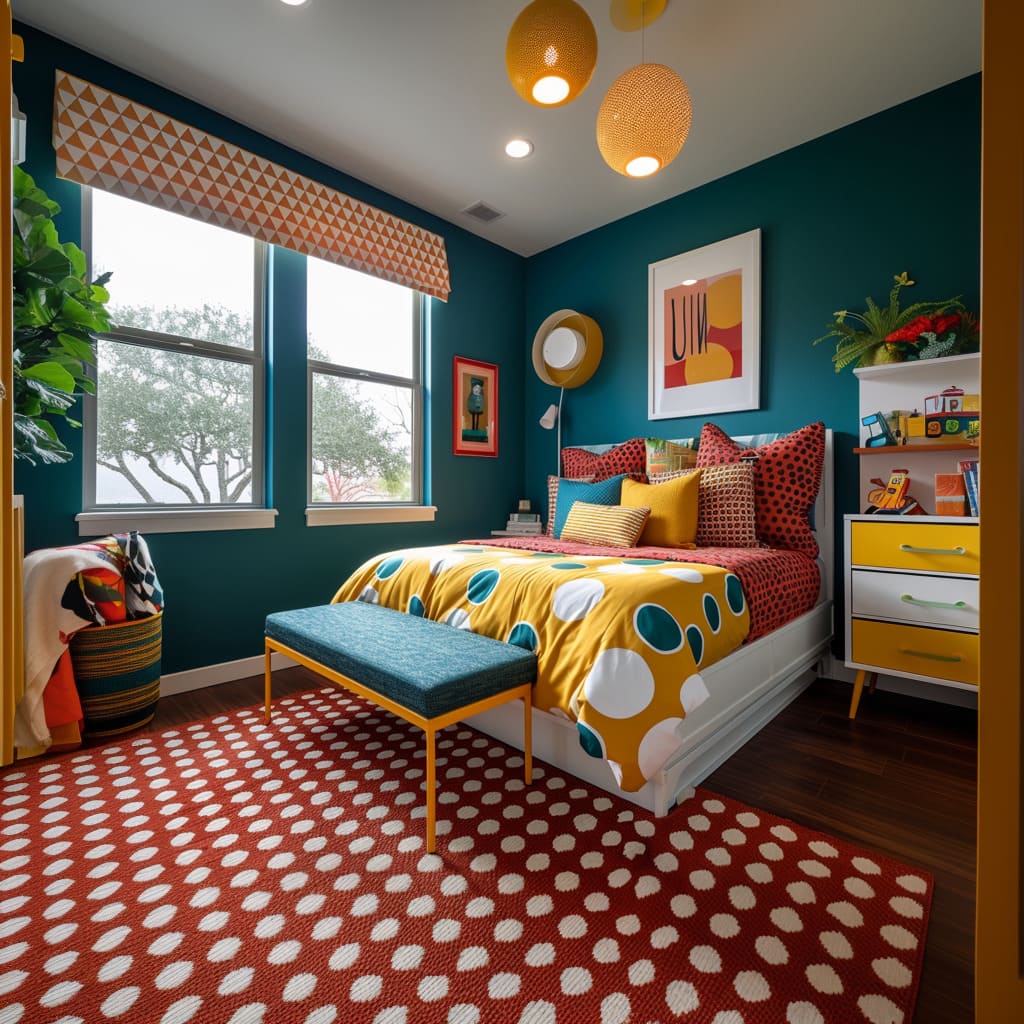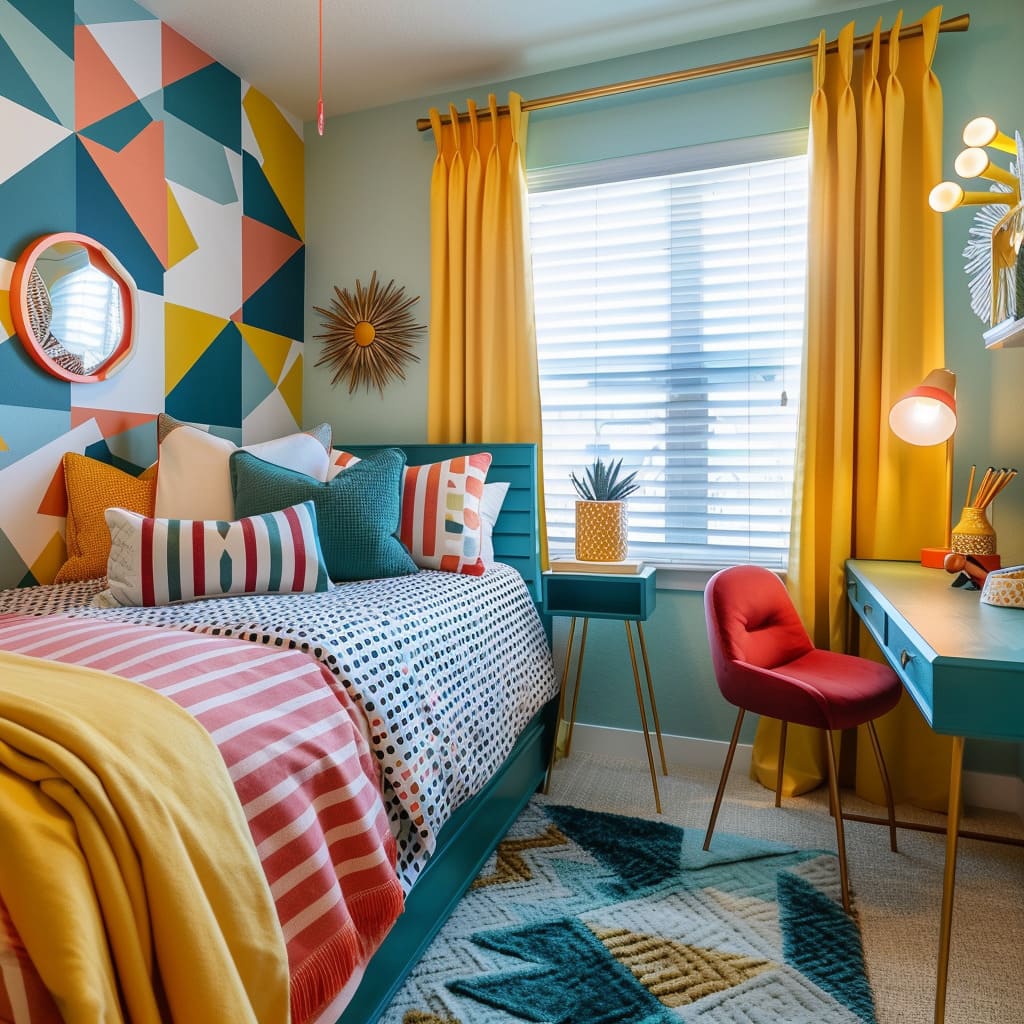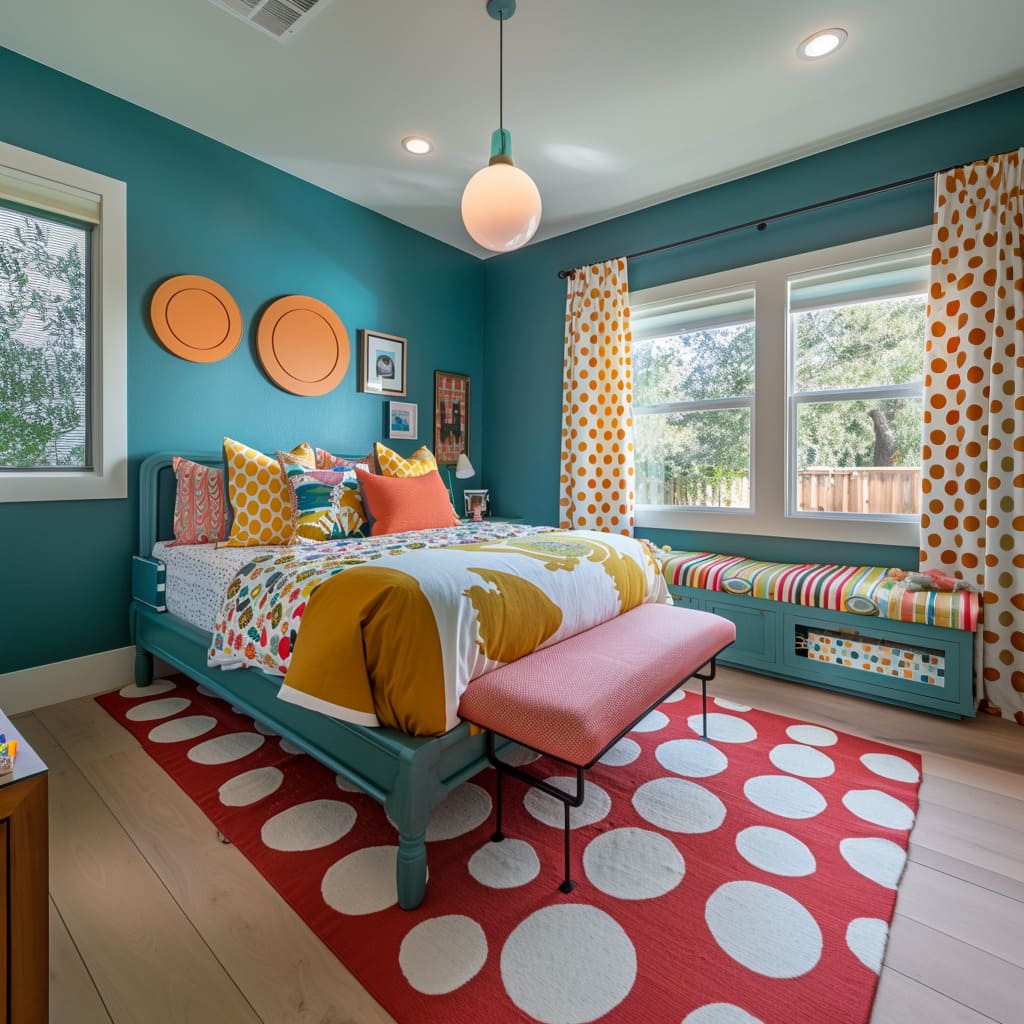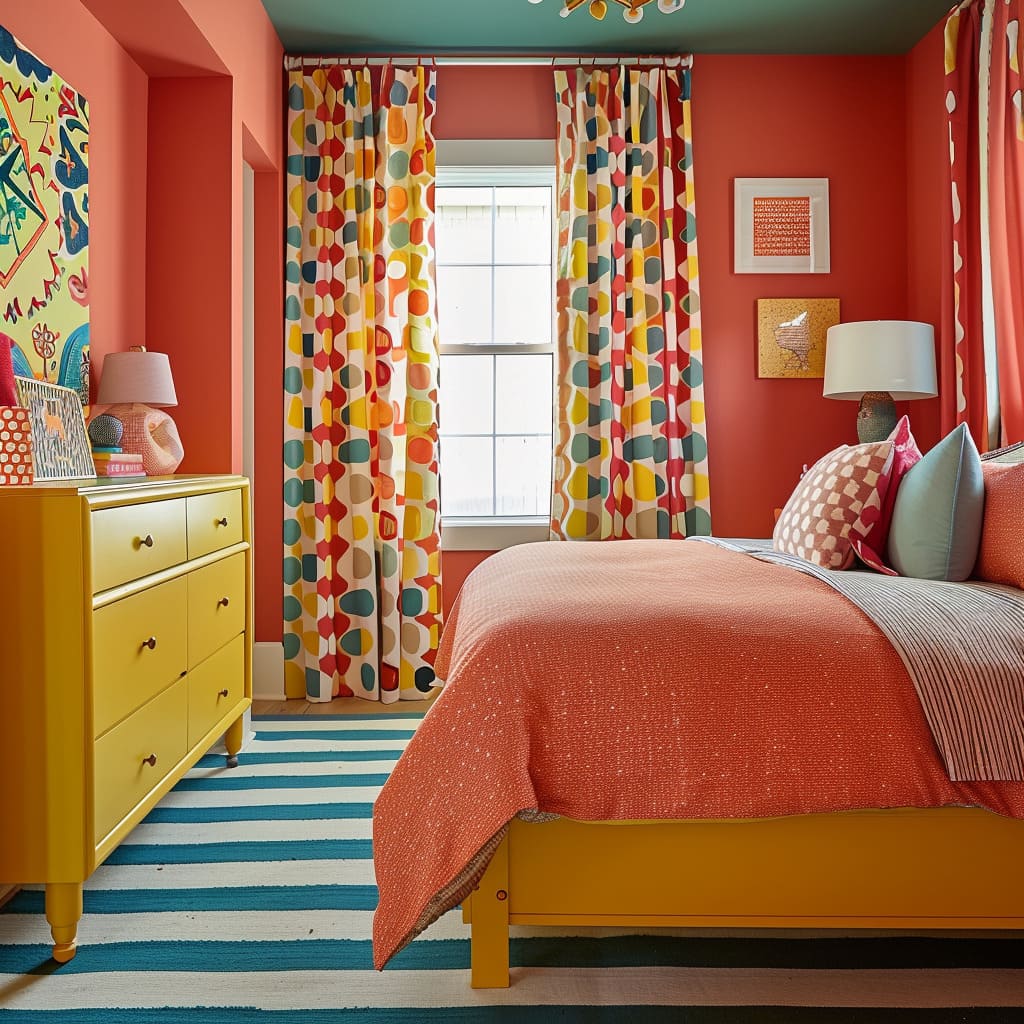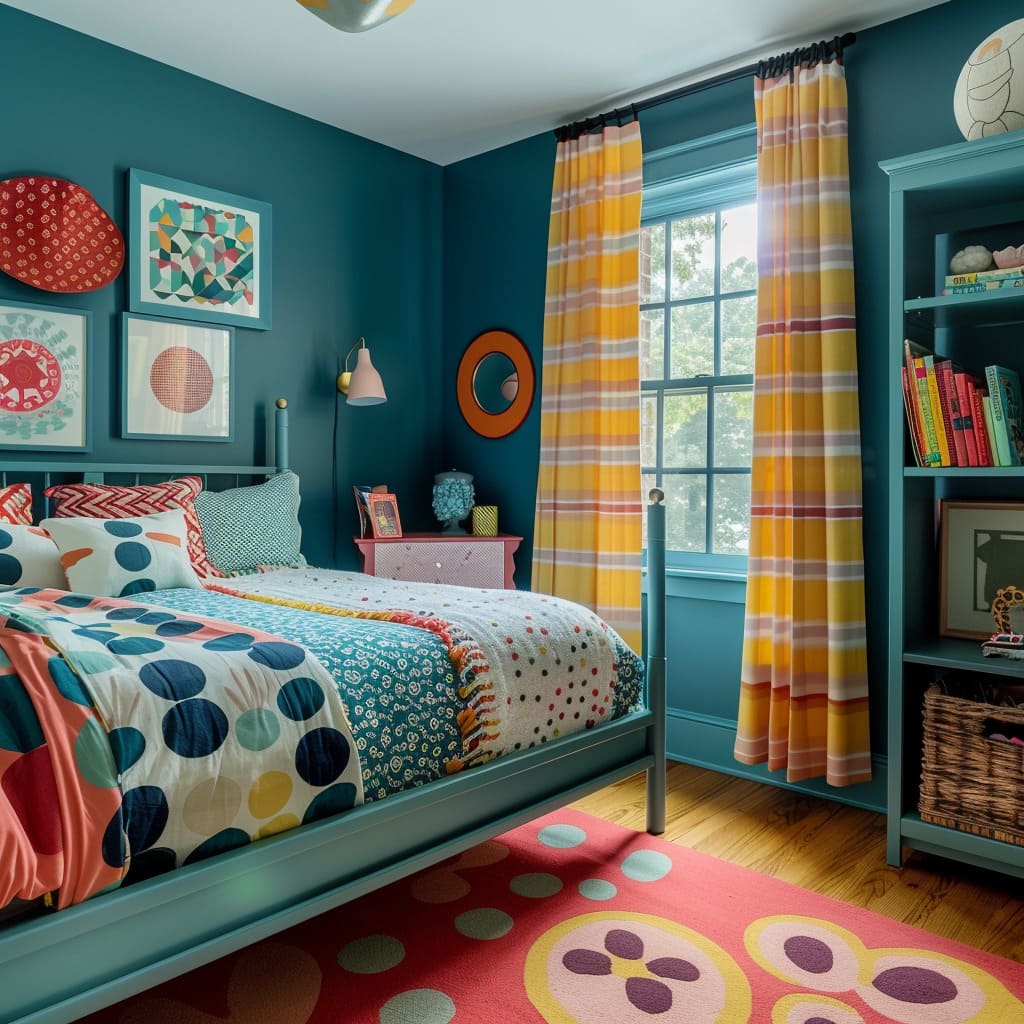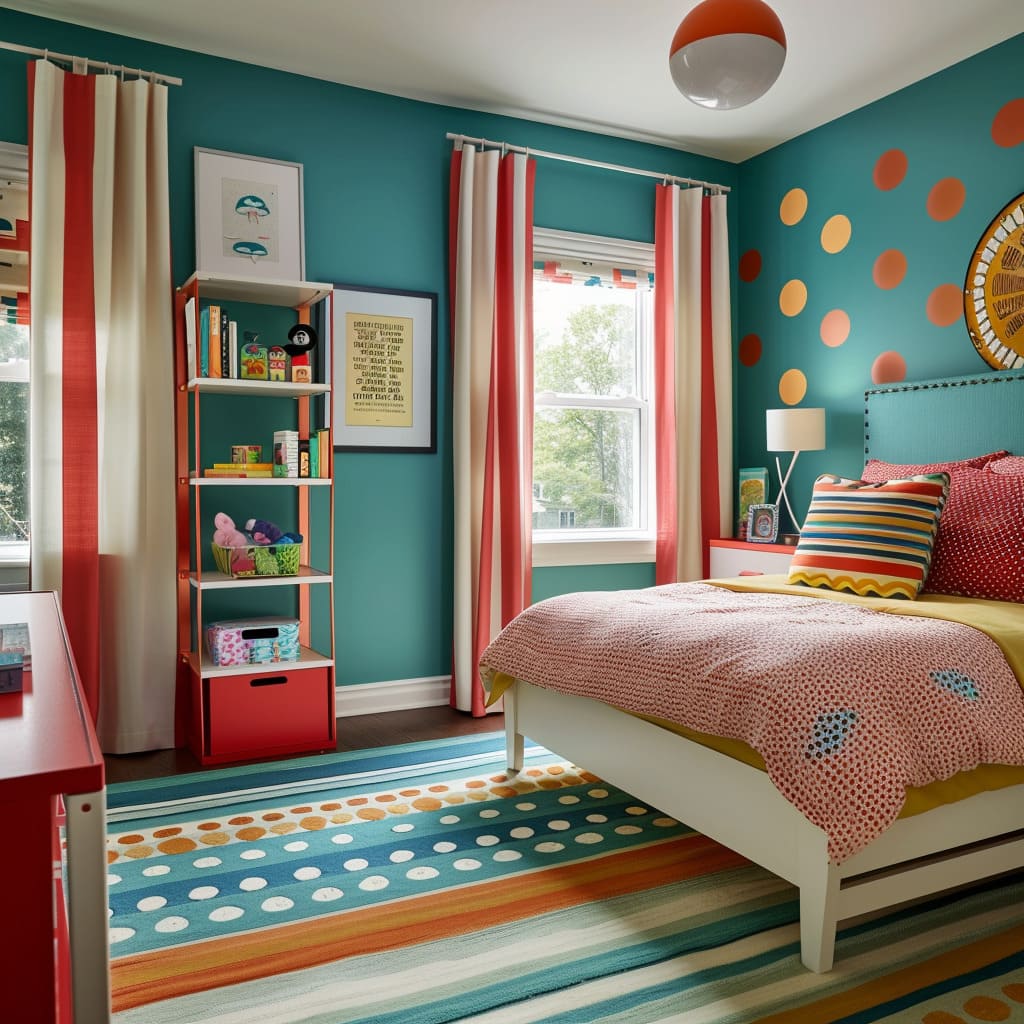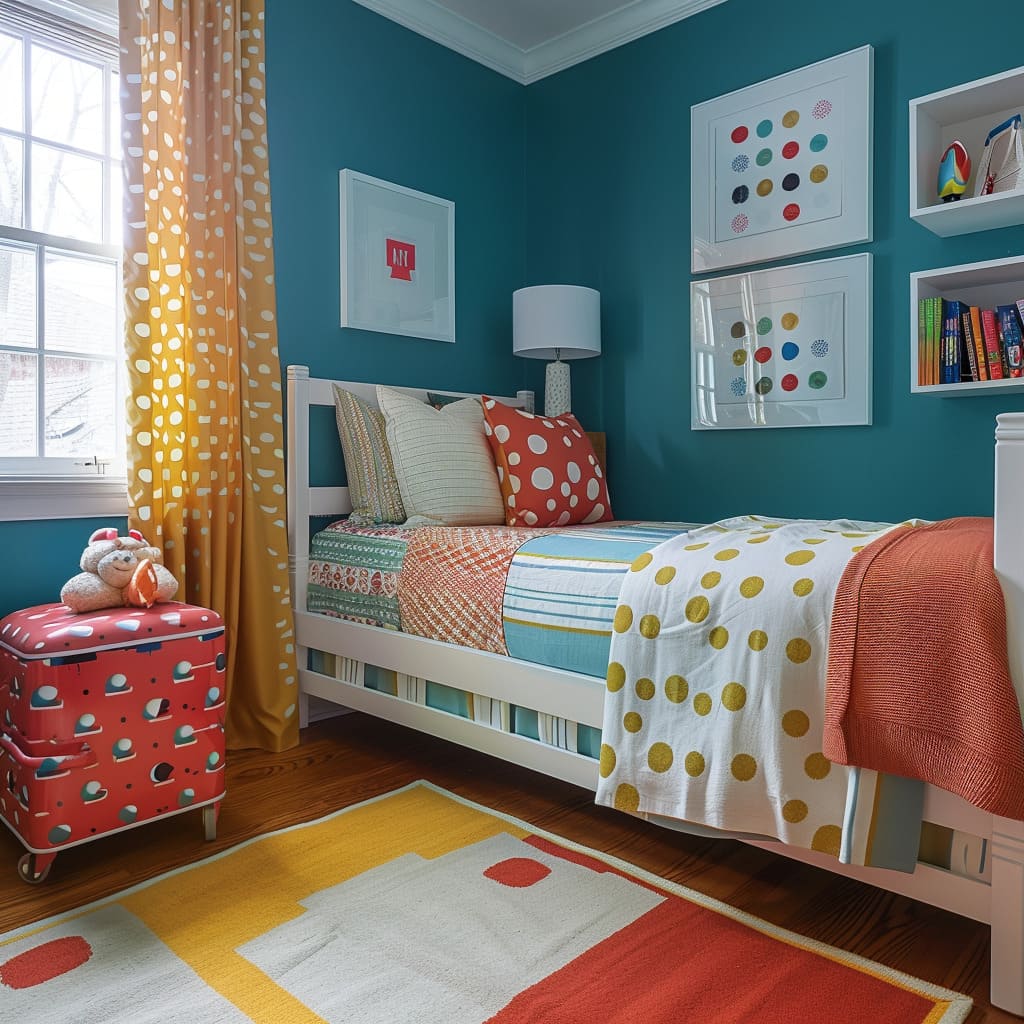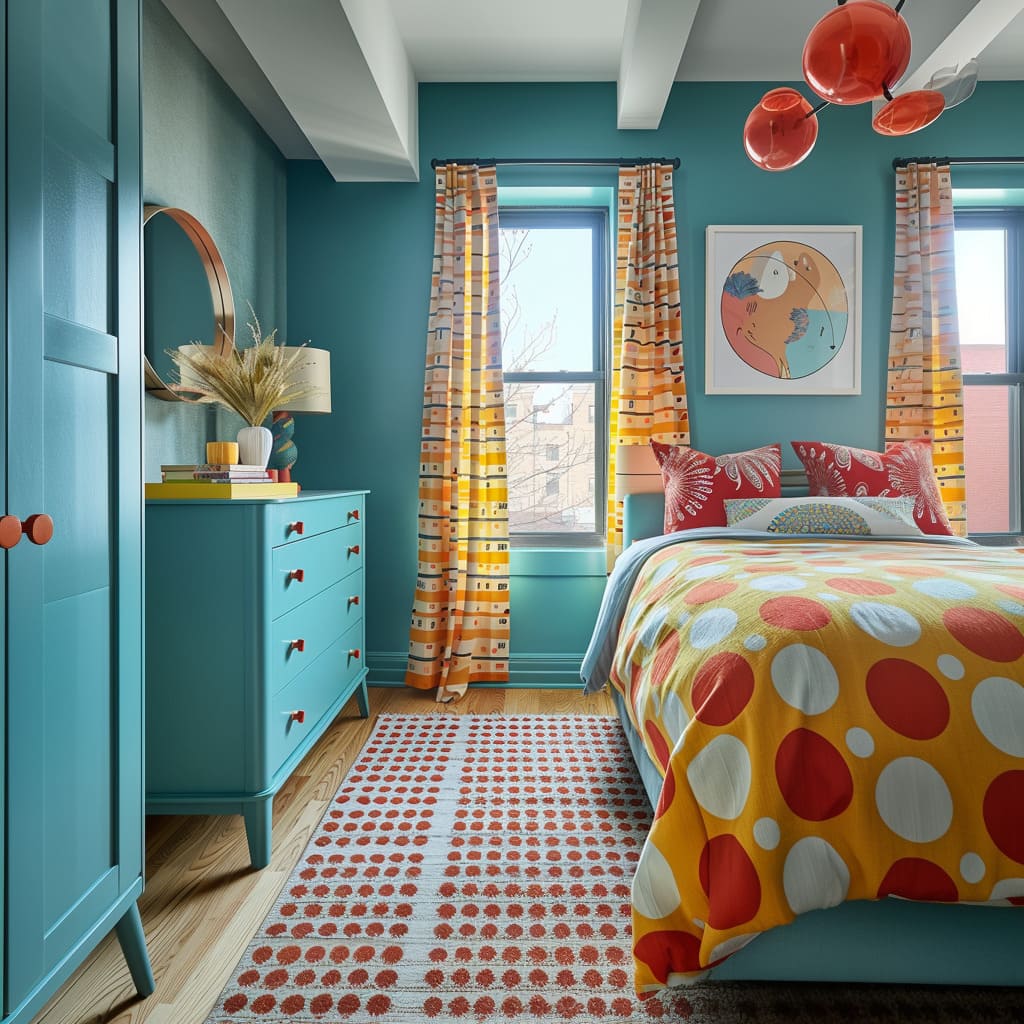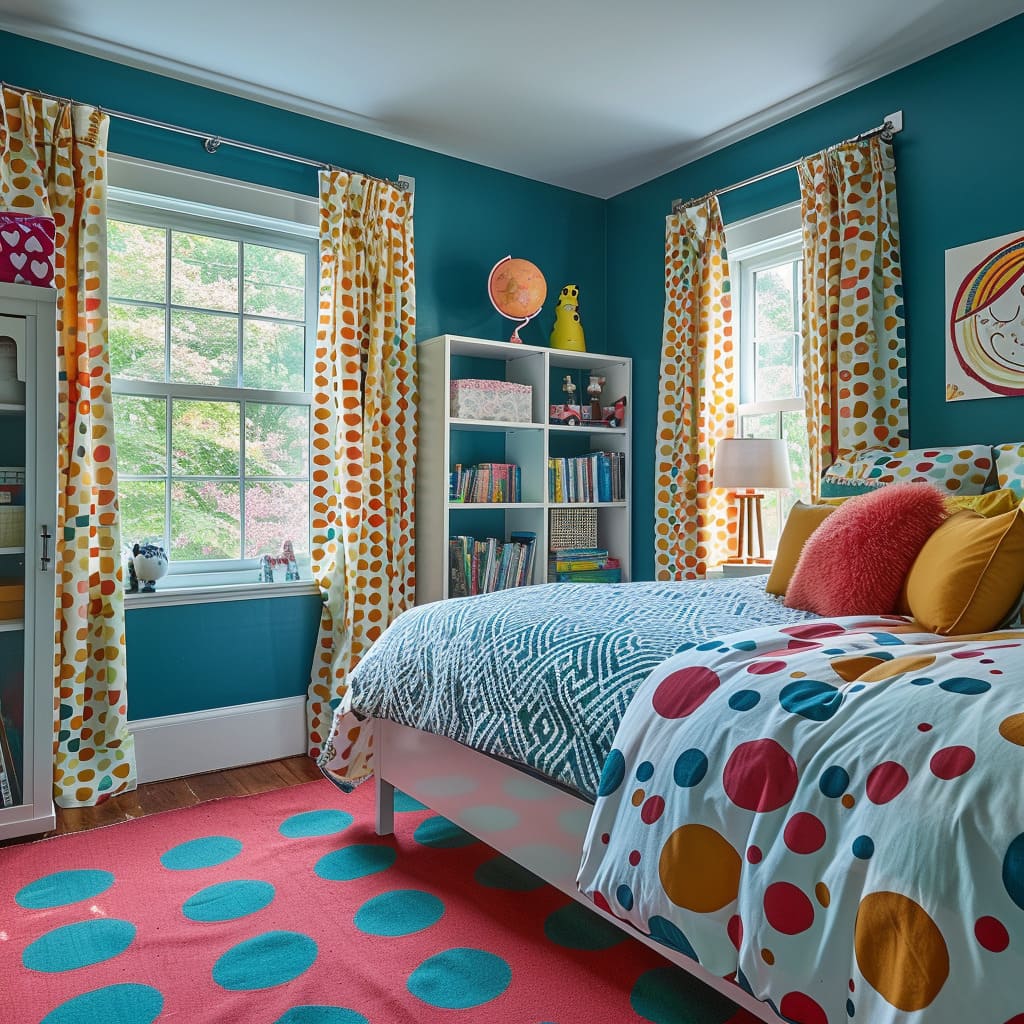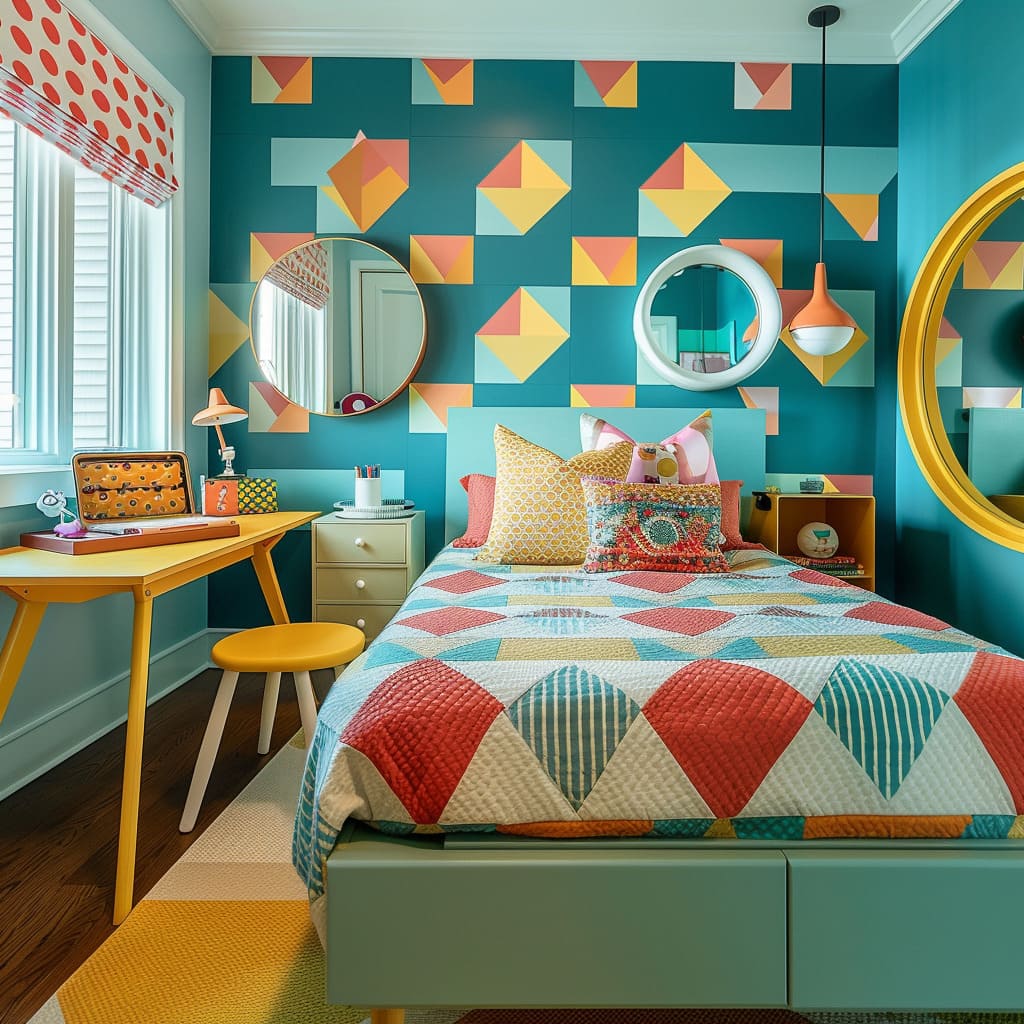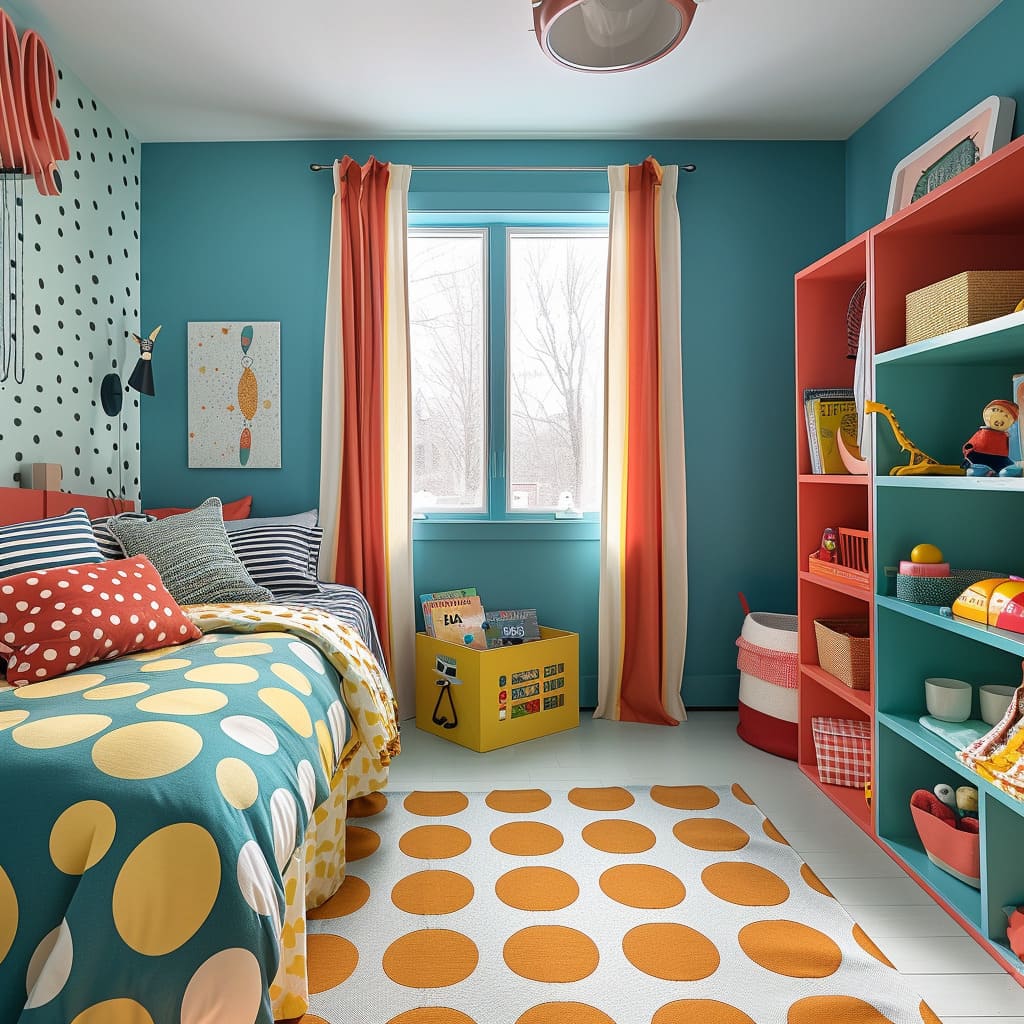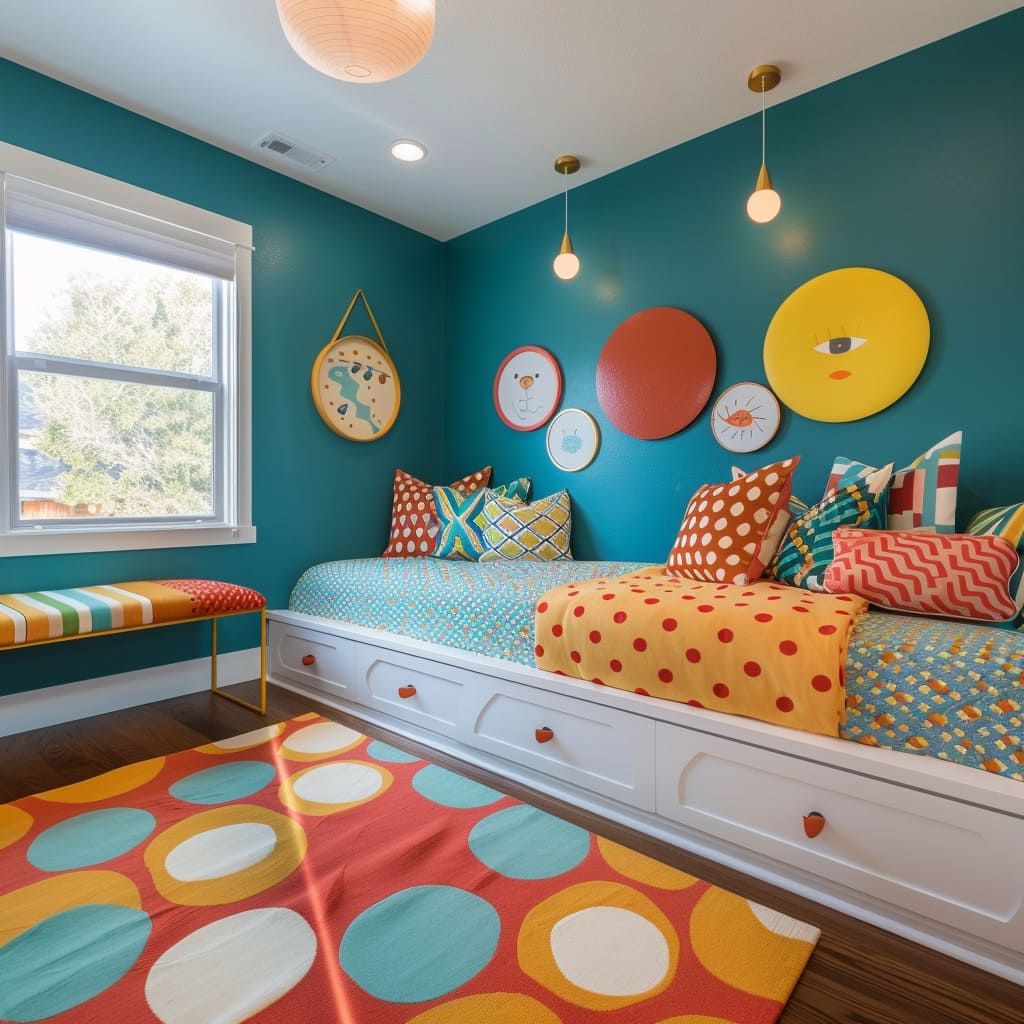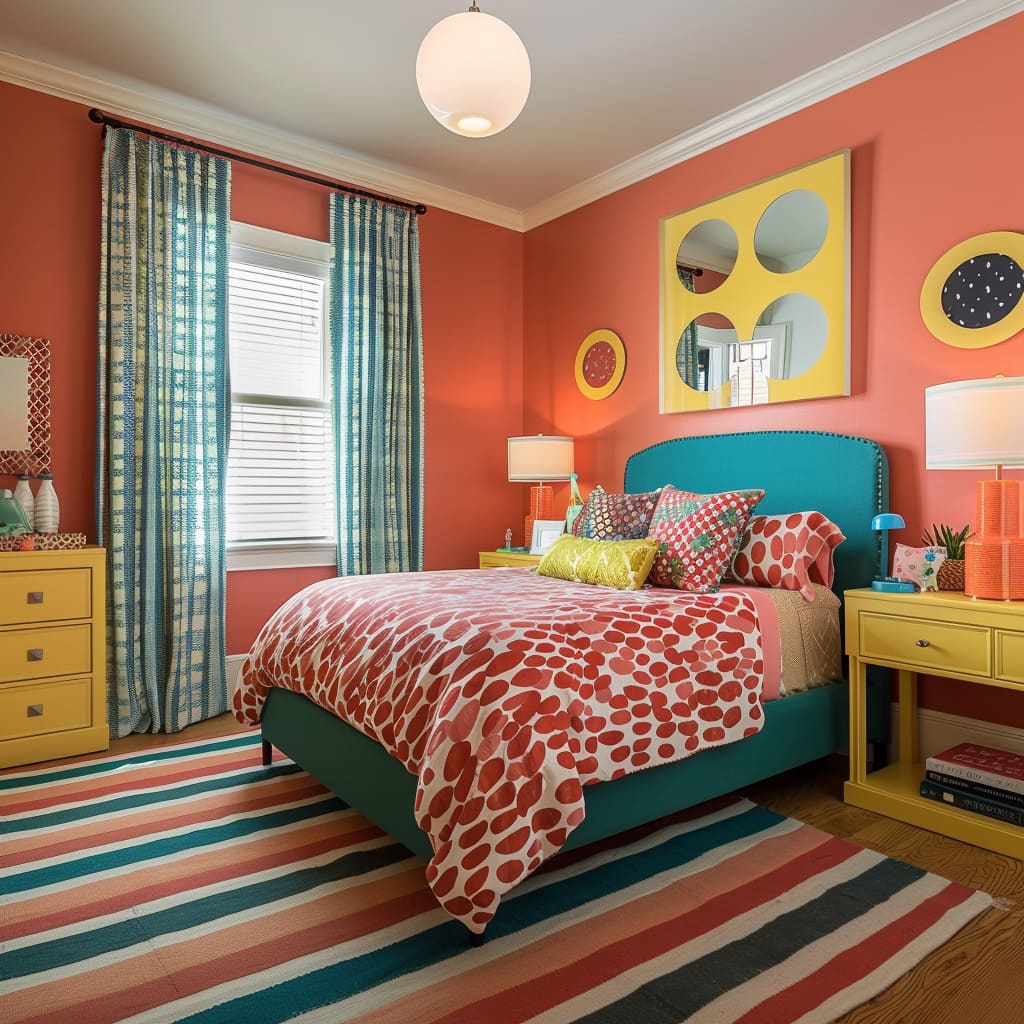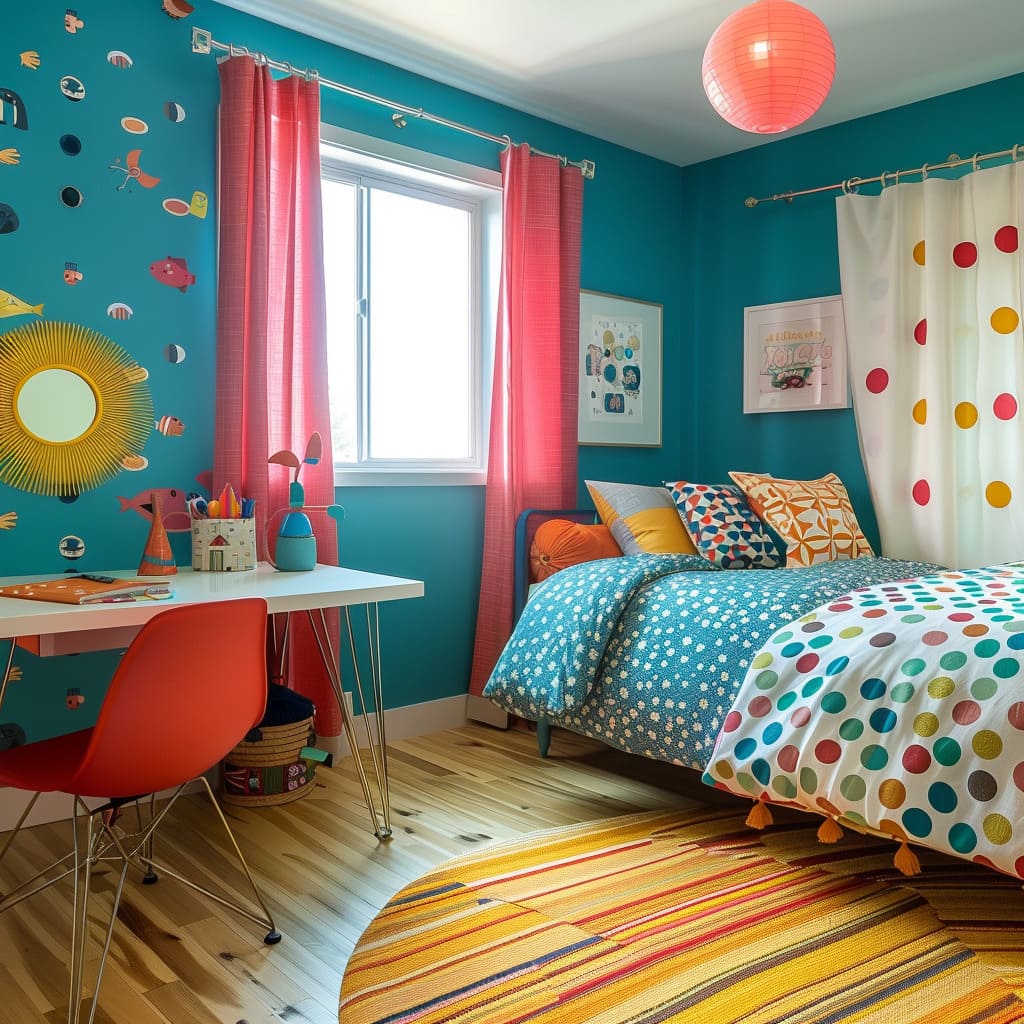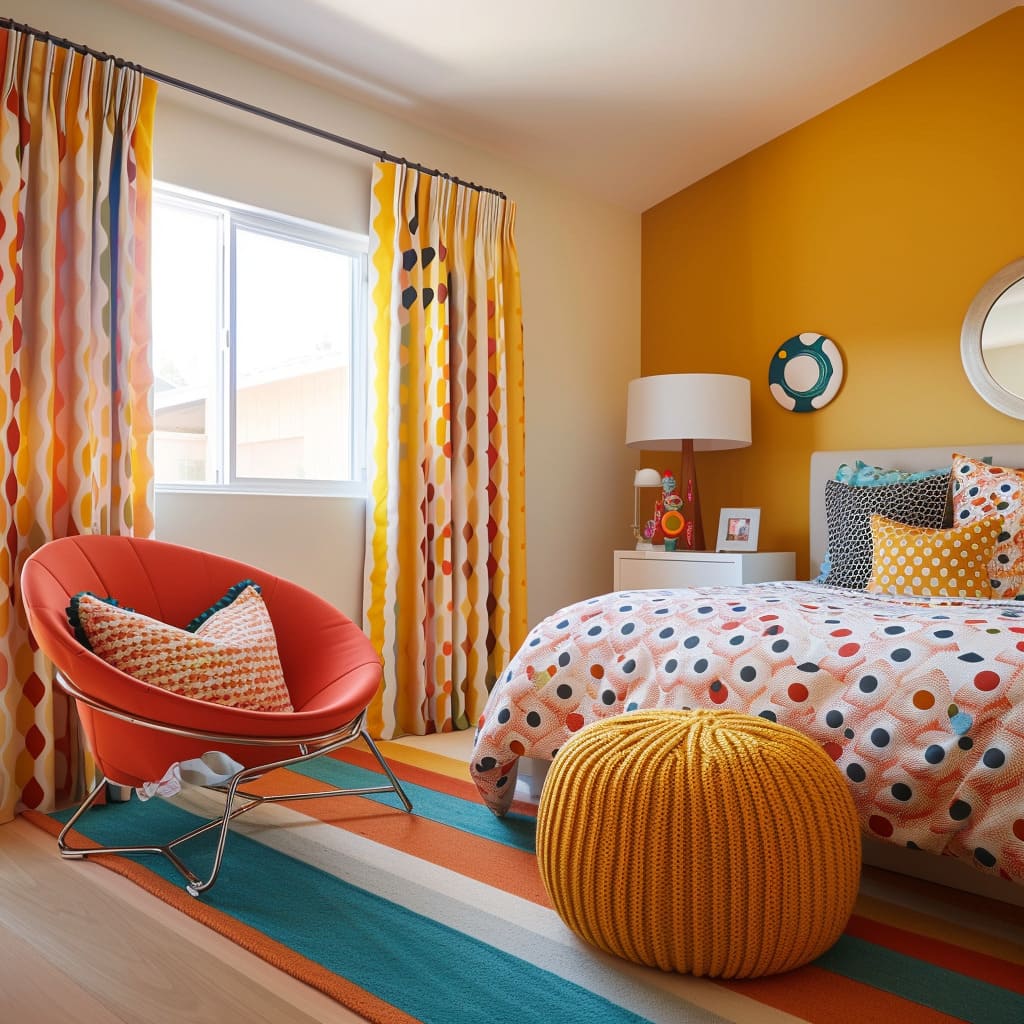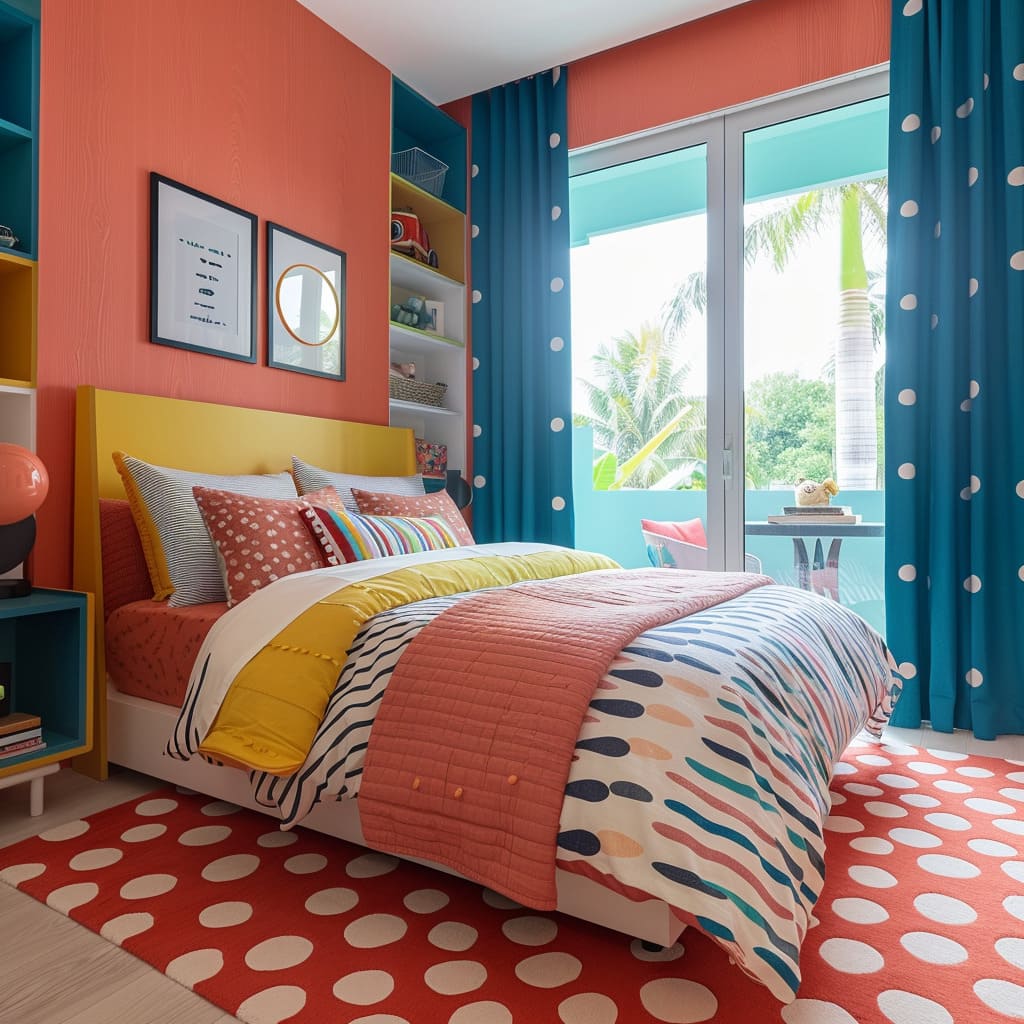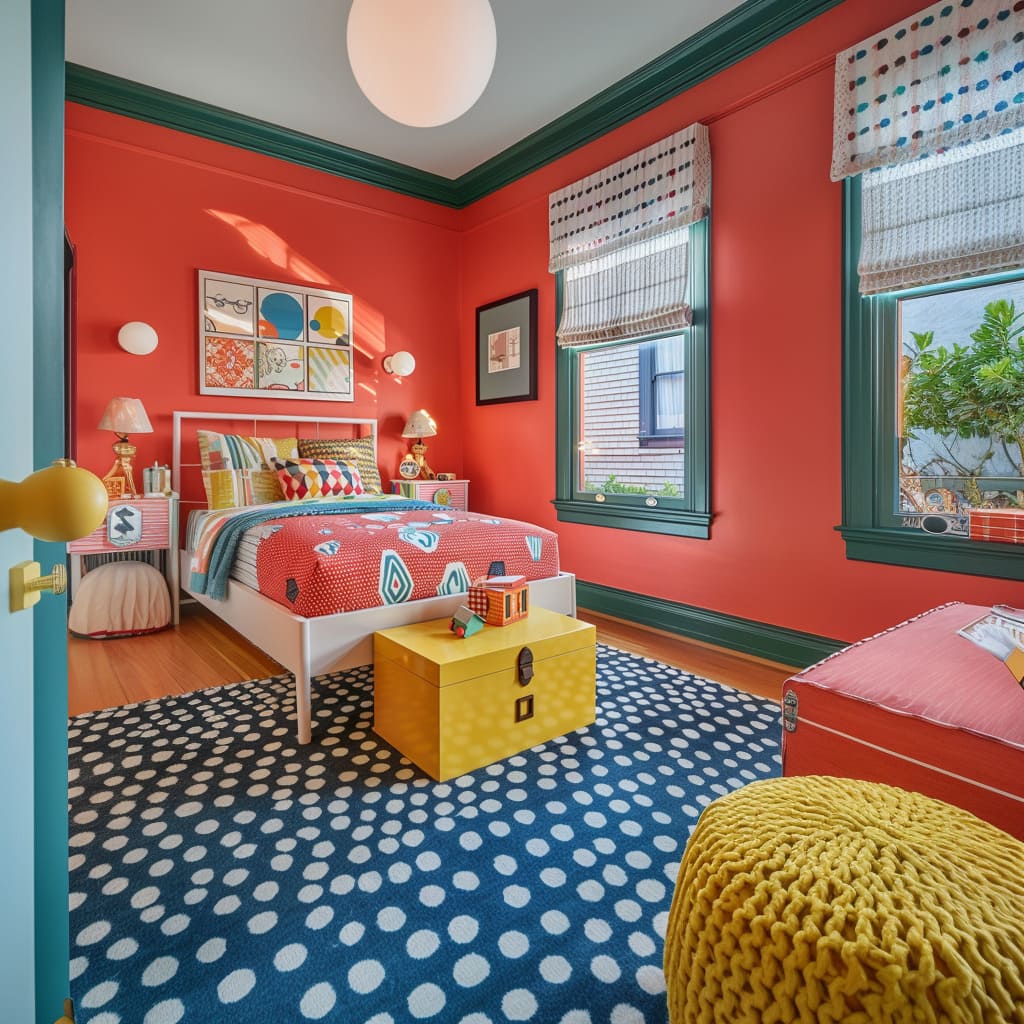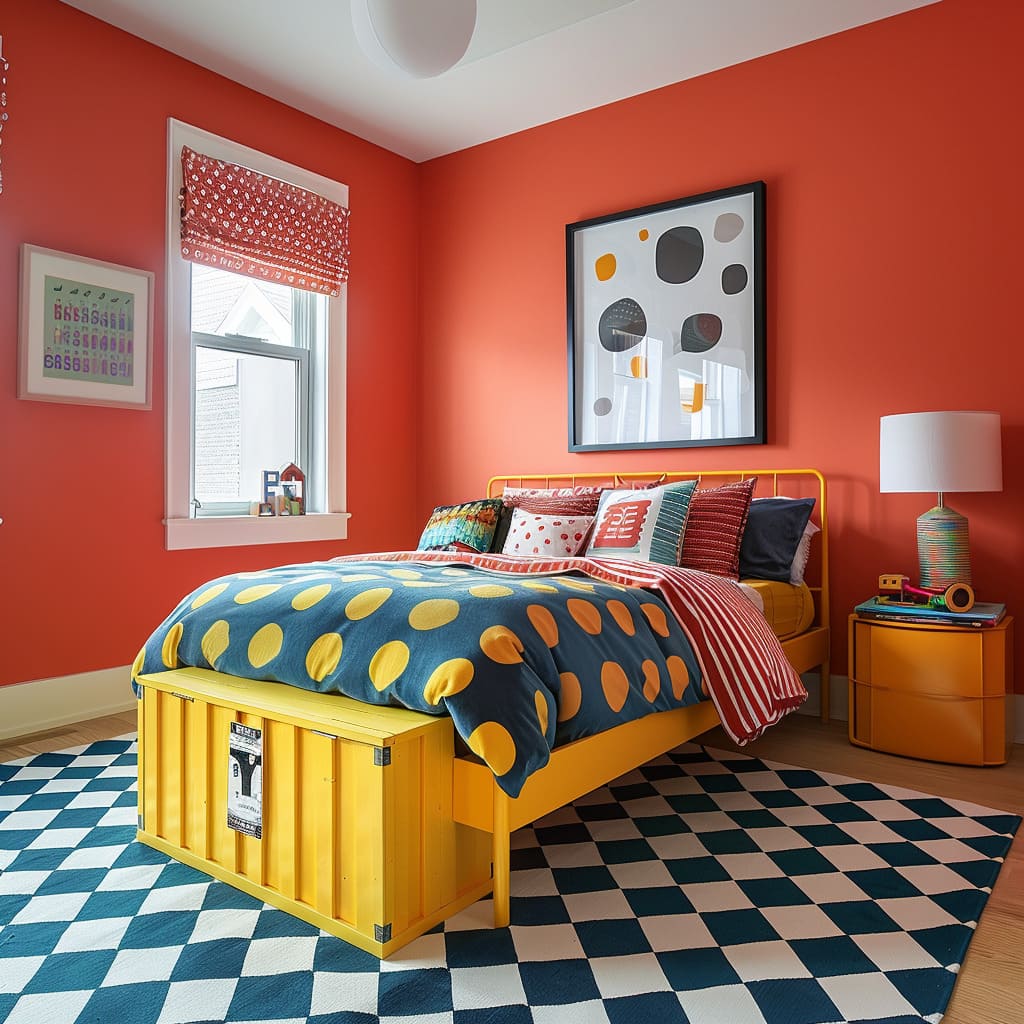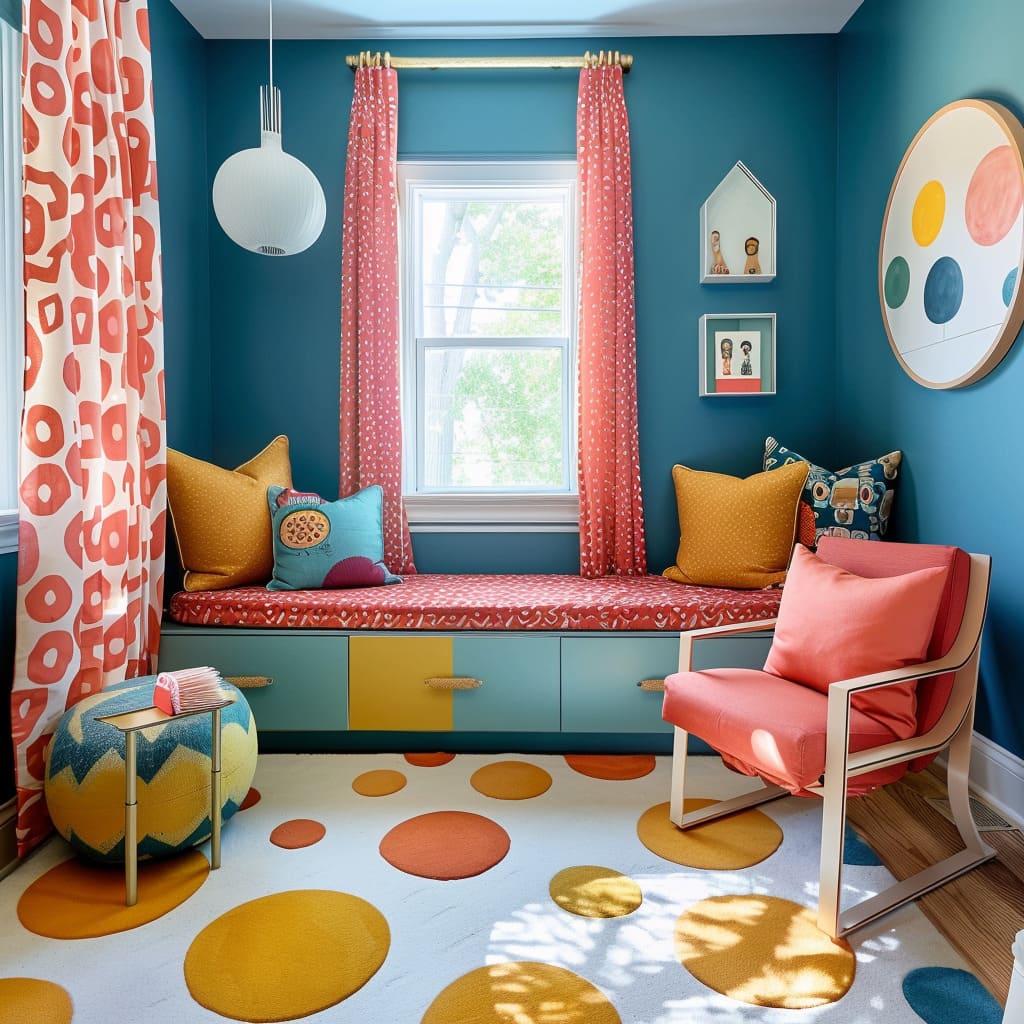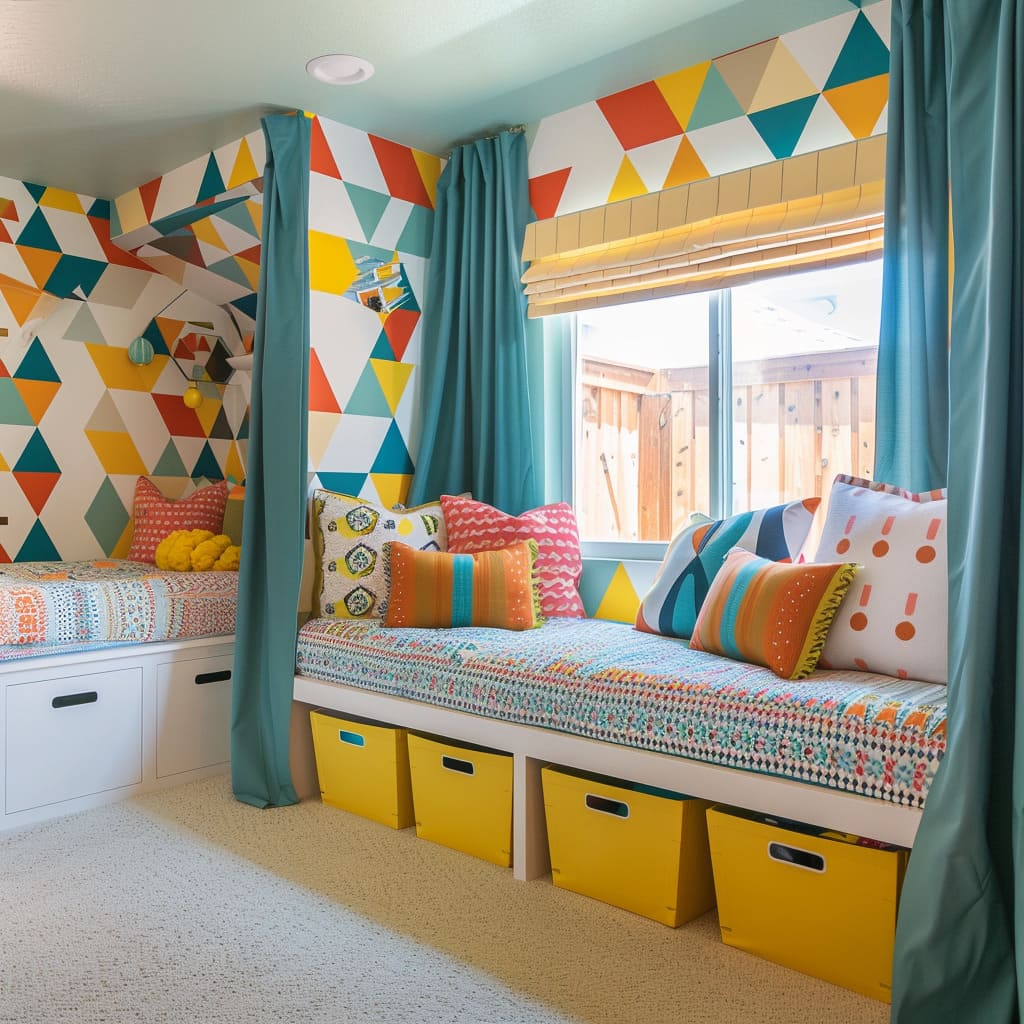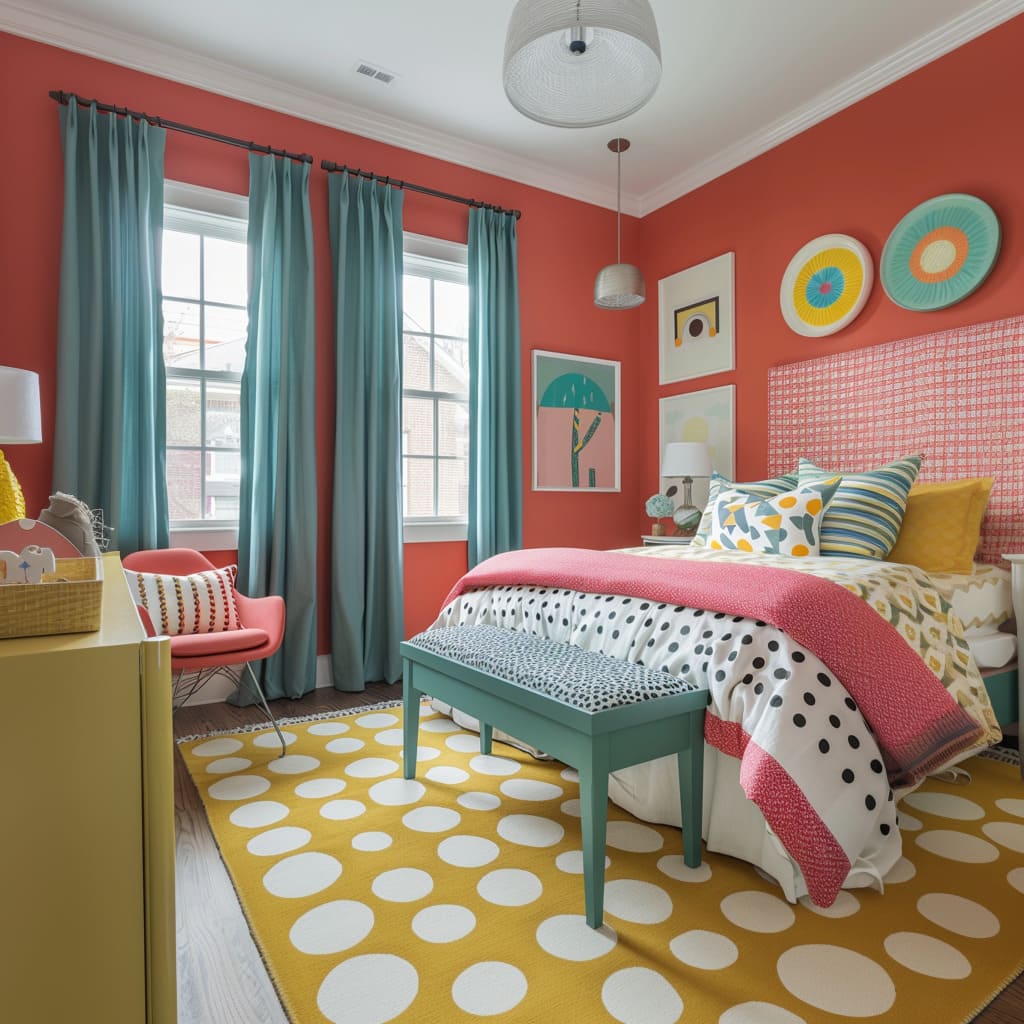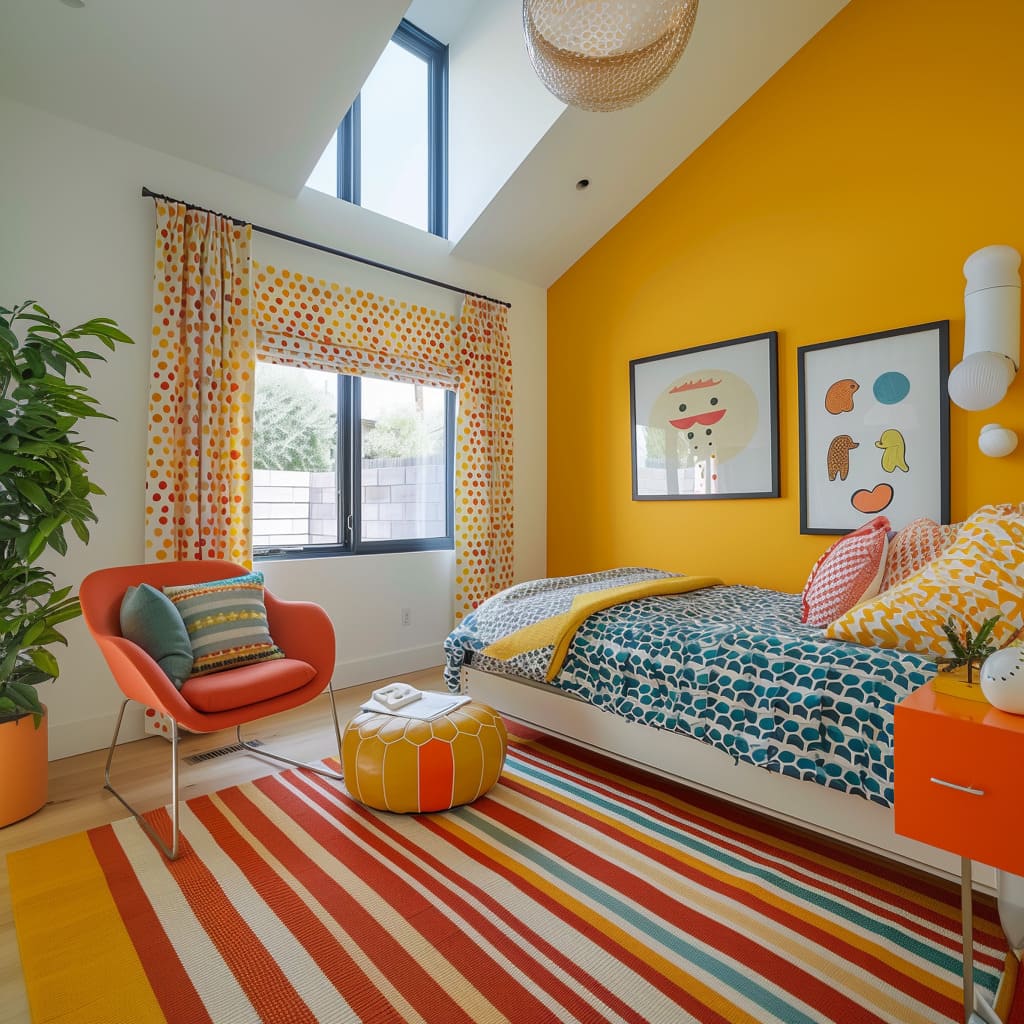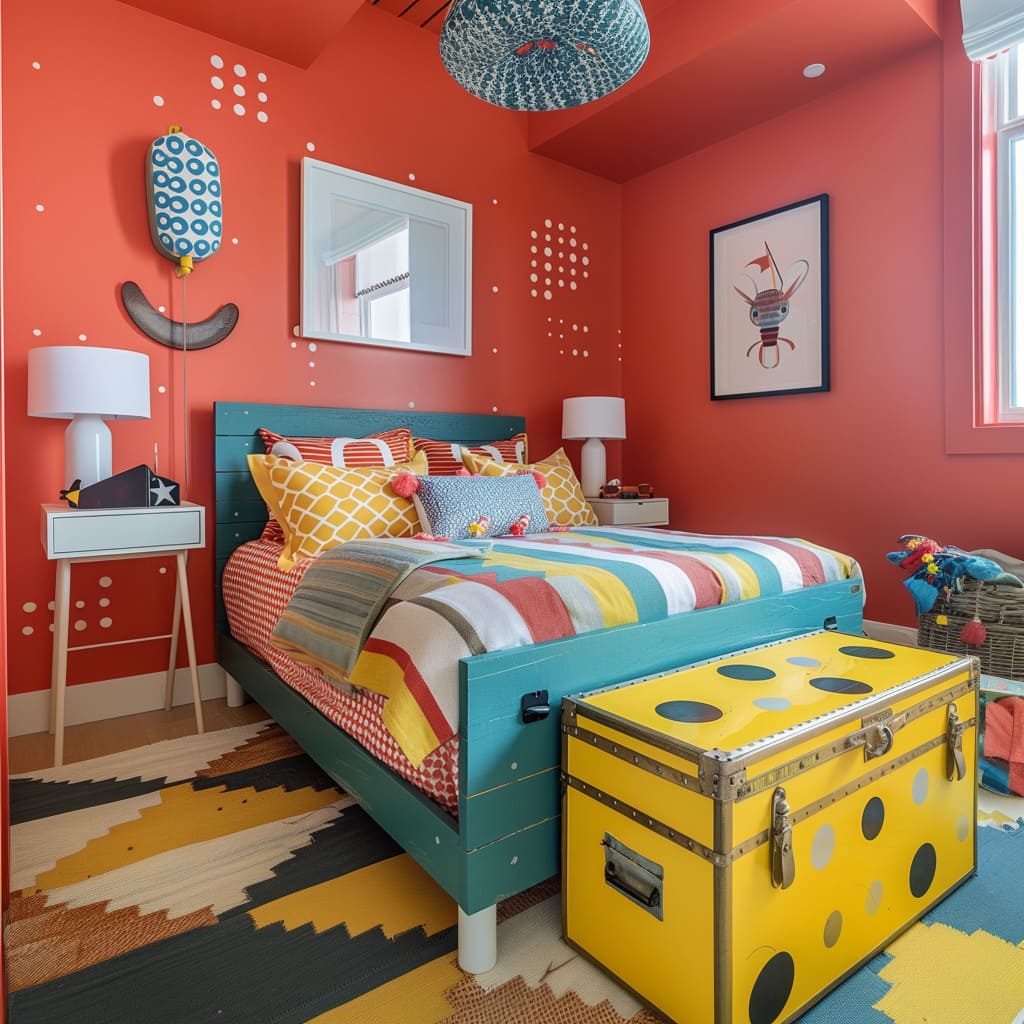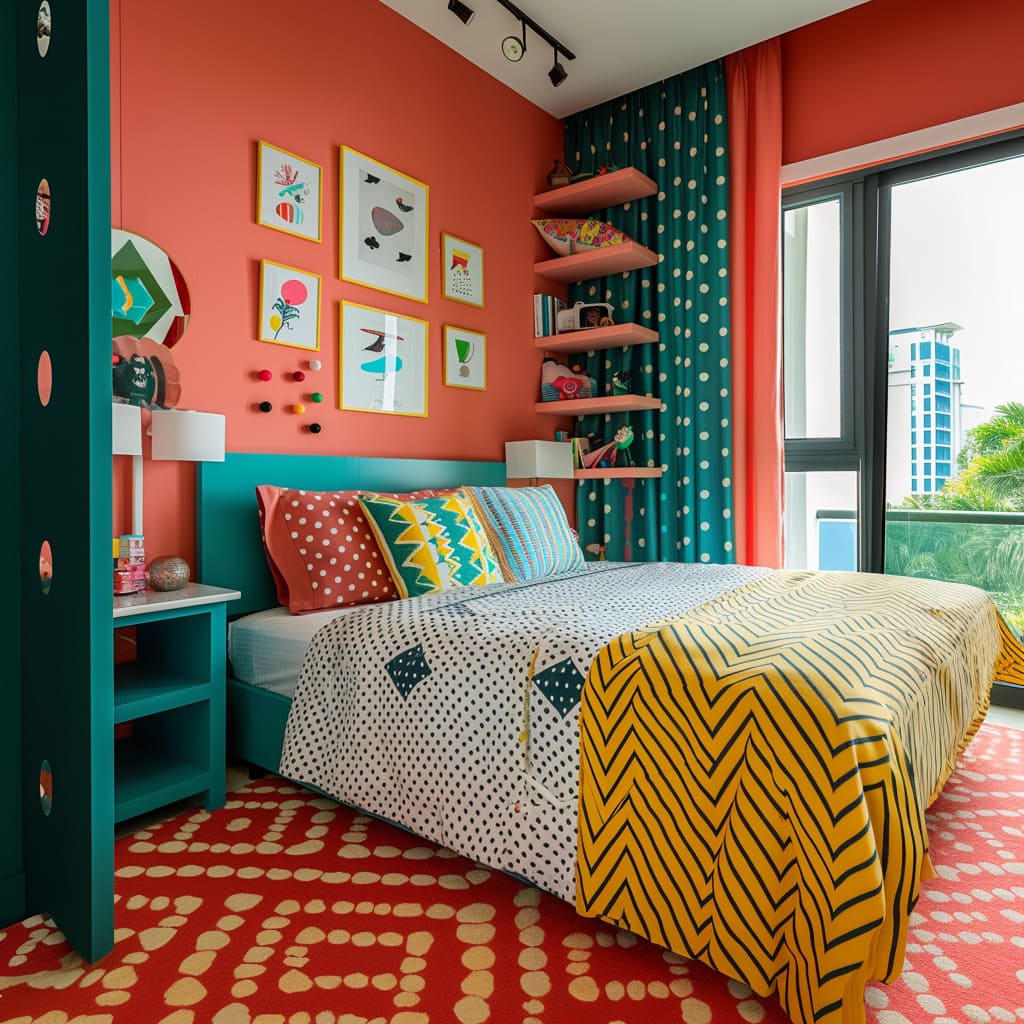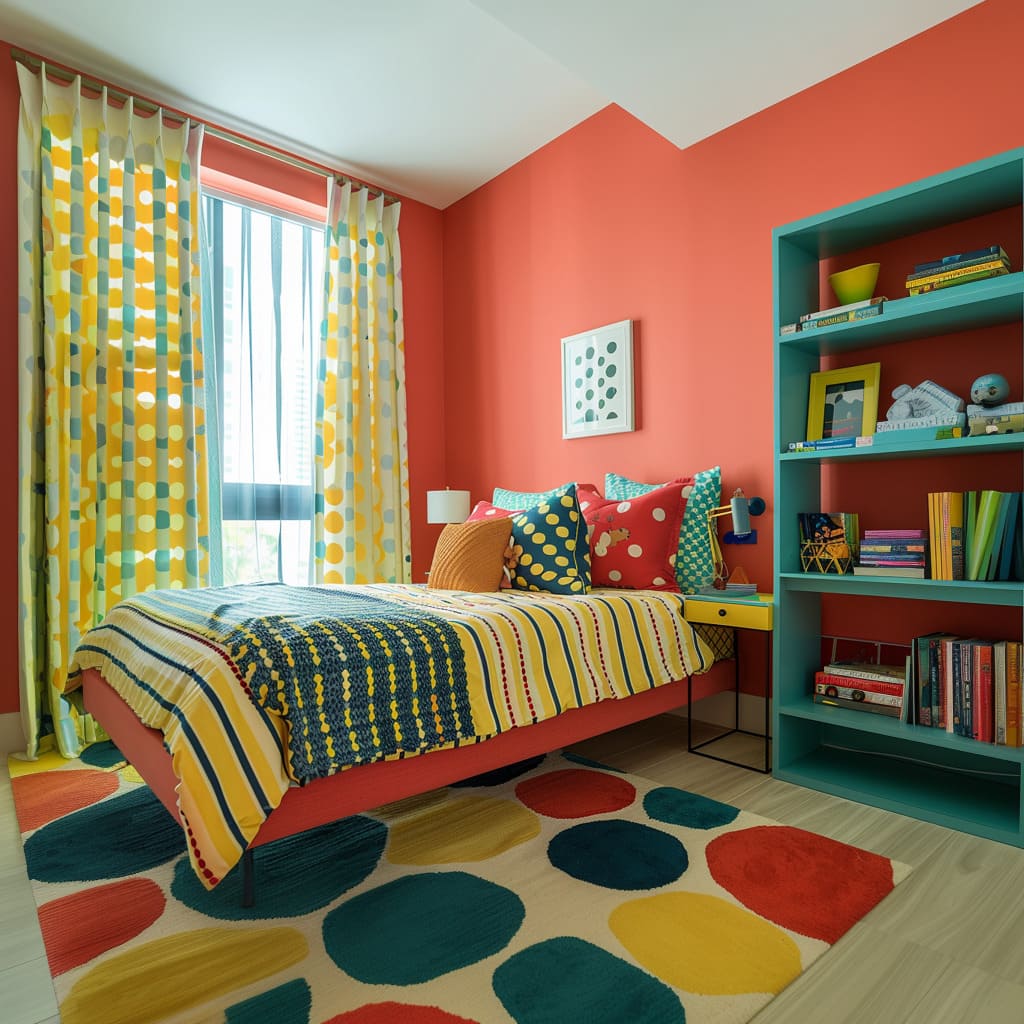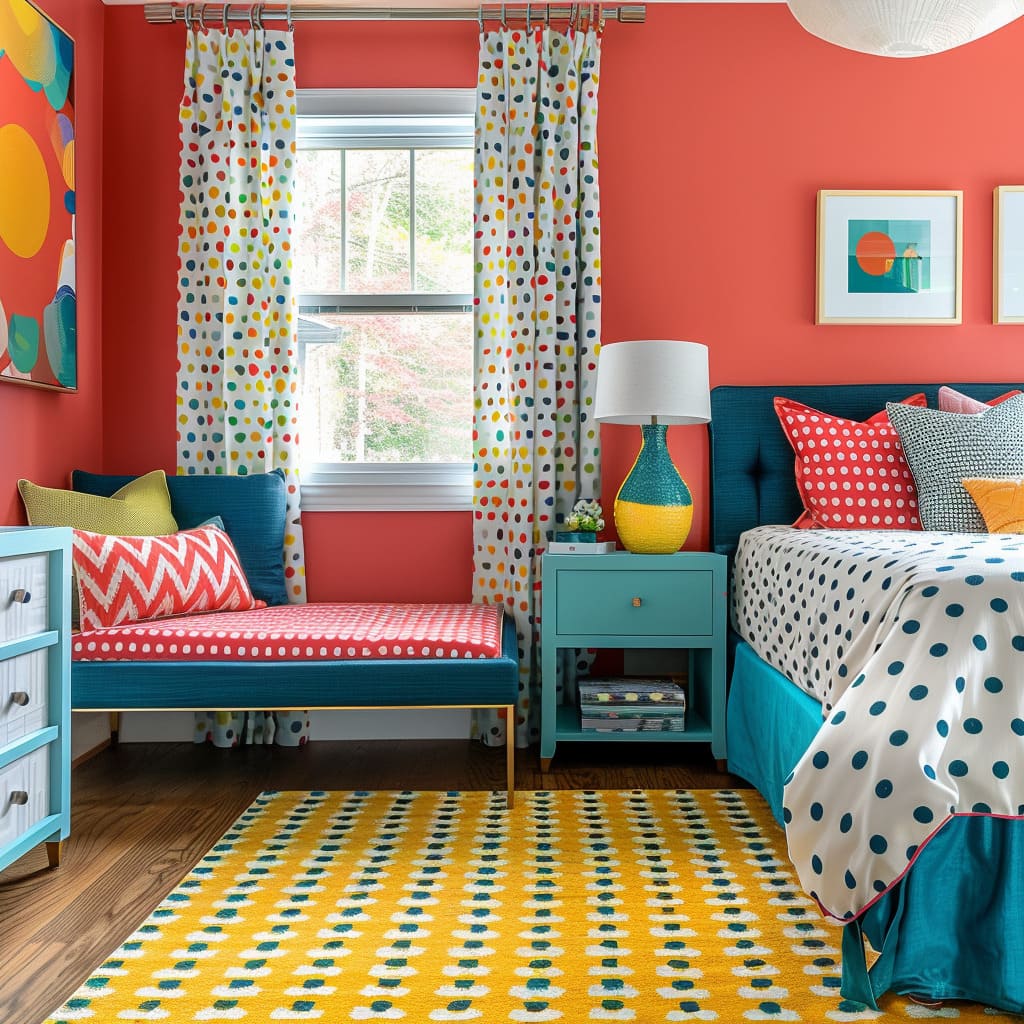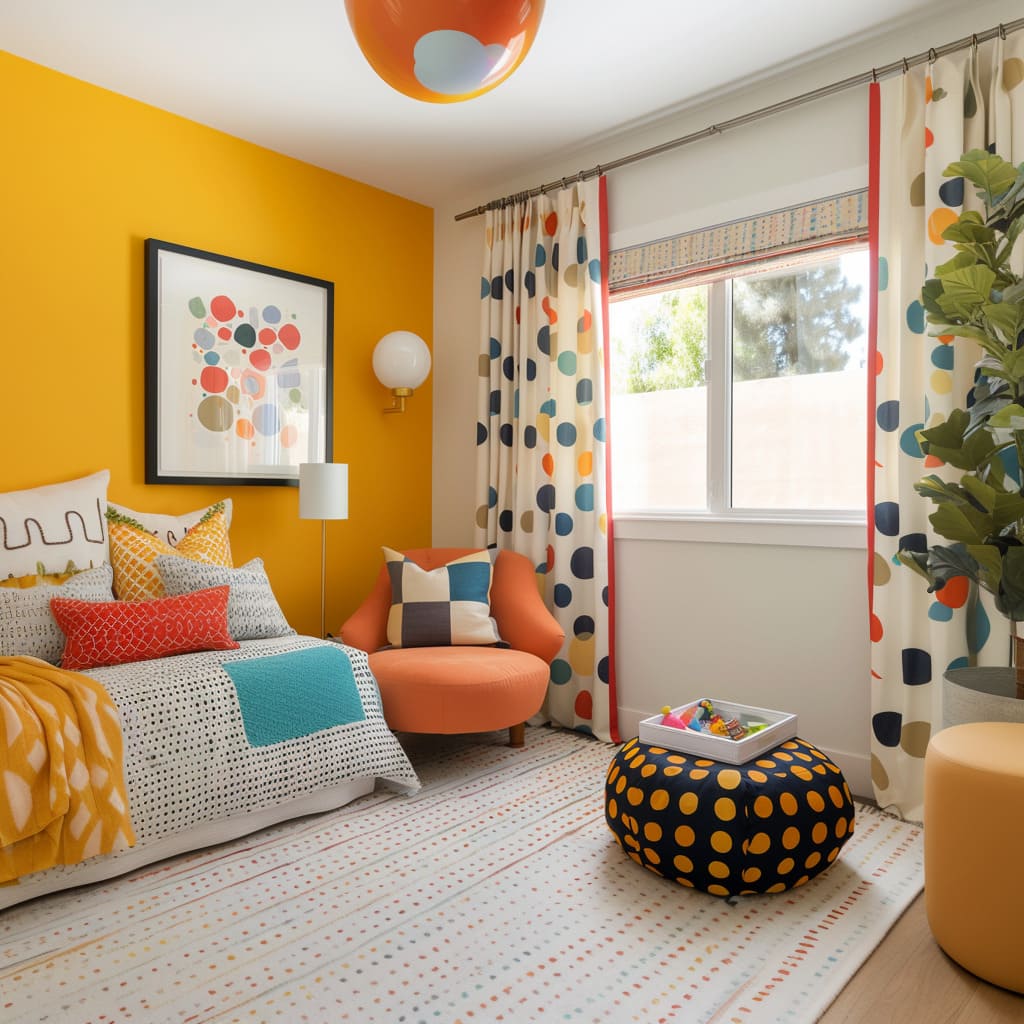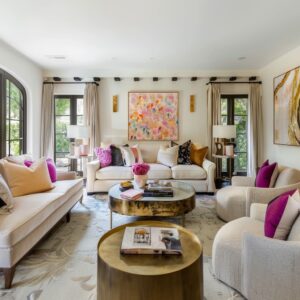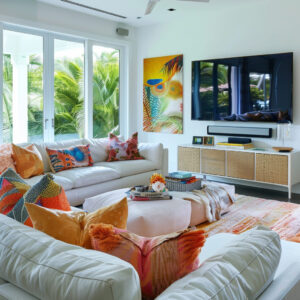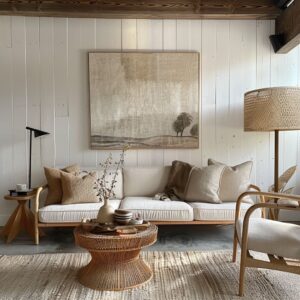Decorating a child’s bedroom is a wonderful opportunity to create a space that reflects their personality and interests. Vibrant and playful designs can make a room not only functional but also a place where a child feels inspired and happy.
Bold colours and patterns are essential elements in achieving this, as they can transform a room from ordinary to extraordinary.
The importance of using bold colours in a child’s room cannot be overstated. Bright, eye-catching colours like coral, teal, and yellow can create an engaging and stimulating environment that captures a child’s imagination.
These colours can energize the room, making it a fun place to play, study, and rest. When thinking about childrens bedroom decor ideas, it’s important to consider how these colours will interact with other elements in the room.
Patterns also play a crucial role in the overall design. Geometric patterns, polka dots, and other playful designs add visual interest and can make the room feel dynamic.
Incorporating patterns into the room’s decor helps create a cohesive and lively space that can grow with the child’s changing tastes and needs. In this article, we will explore various aspects of decorating a kid’s bedroom with bold colours and patterns.
We will cover topics such as selecting the right wall colours, choosing complementary window treatments, picking vibrant bedding and textile patterns, selecting statement rugs and flooring, finding functional and colourful furniture, and incorporating decorative elements and lighting. Each section will provide detailed and practical tips to help you create a vibrant and inviting space for your child.
Setting the Tone with Wall Colours
Choosing Bold Wall Colours
The wall colour is the foundation of any room design, and selecting a bright, eye-catching colour is key to setting the tone for a child’s room. Bold wall colours can make a significant impact and create a vibrant atmosphere.
Colours like coral, teal, and yellow are particularly effective in children’s bedrooms as they are both stimulating and cheerful. Coral is a warm and inviting colour that can make a room feel cozy yet lively.
It pairs well with a variety of other colours and can serve as a great backdrop for various patterns and decor elements. Teal, on the other hand, brings a cool and refreshing vibe to the room. It’s a versatile colour that can work well with both warm and cool tones, making it a popular choice for kids’ rooms.
Yellow is a bright and sunny colour that can instantly lift the mood of the room. It’s perfect for creating a happy and energetic space.
When selecting a wall colour, it’s important to consider how it will interact with the other elements in the room, such as furniture, bedding, and accessories. The goal is to create a harmonious look that feels both cohesive and dynamic.
Incorporating Patterns
In addition to bold colours, incorporating patterns into the wall design can add an extra layer of interest and playfulness. Geometric patterns, such as triangles, hexagons, and stripes, can create a modern and dynamic look.
Polka dots are another great option, adding a whimsical touch to the room. When using patterns, it’s important to balance them with solid colours to avoid overwhelming the space.
For example, if you choose a bold geometric pattern for one wall, consider painting the other walls in a solid colour that complements the pattern. This approach ensures that the room feels lively without being too chaotic.
Another tip is to use patterns to highlight specific areas of the room. For example, you can use a patterned wallpaper behind the bed to create a focal point or in a reading nook to make it stand out.
This not only adds visual interest but also helps define different areas within the room. By thoughtfully combining bold colours and patterns, you can create a vibrant and engaging space that reflects your child’s personality and interests.
This approach to decorating a child’s room not only makes it a fun place to be but also supports their creativity and development. Whether you’re exploring childrens bedroom furniture ideas or looking for kiddie room ideas, the key is to be bold and playful with your choices.
Window Treatments
Curtain Choices
Selecting the right curtains is essential in creating a harmonious and visually appealing bedroom for a child. Curtains not only serve a practical purpose by providing privacy and controlling light but also contribute significantly to the room’s overall aesthetic.
When choosing curtains, it’s important to select colours and patterns that complement the existing wall colours and decor. For example, teal curtains paired with coral walls create a striking contrast that is both vibrant and balanced.
This combination of cool and warm tones can enhance the room’s dynamic feel and make the space more engaging for a child. Patterns on curtains can also play a crucial role in adding visual interest.
Geometric designs, polka dots, and playful prints can tie in with other patterns used in the room, such as those on bedding and rugs. The key is to ensure that the patterns do not clash but rather complement each other, creating a cohesive look.
For instance, if the room features a lot of geometric patterns, choosing curtains with a subtle polka dot design can add variety without overwhelming the space. In addition to patterns, the material of the curtains is another factor to consider.
Light, airy fabrics can allow natural light to filter through, creating a bright and cheerful atmosphere, while heavier fabrics can provide better light control and privacy. The choice of fabric should align with the overall theme and functionality of the room.
Additional Window Treatments
Beyond curtains, other window treatments such as blinds and valances can add both functionality and aesthetic appeal to a child’s bedroom. Blinds are particularly useful for controlling the amount of natural light that enters the room, which can be essential for creating a comfortable environment for sleep and play.
They also offer an additional layer of privacy, which is important for a bedroom. Valances can be used to add a decorative touch to the windows.
They can be designed in various patterns and colours to match or complement the curtains and other decor elements in the room. For example, a valance with a geometric pattern can add a modern touch, while a simpler design can provide a clean, finished look.
When combined with curtains and blinds, valances can create a well-coordinated window treatment that enhances the room’s overall decor. Using a combination of these window treatments allows for versatility in light control and adds layers of visual interest.
For instance, a room with teal curtains, white blinds, and a patterned valance can offer a balanced mix of style and functionality, making the window area a focal point of the room.
Bedding and Textile Patterns
Selecting Vibrant Bedding
Bedding is one of the most important elements in a child’s bedroom, as it sets the tone for comfort and style. Choosing colourful and patterned bedding can significantly impact the room’s atmosphere.
Bright, vibrant bedding can make the room feel lively and welcoming, encouraging a cheerful mood. Patterns such as polka dots, stripes, and abstract designs add a playful touch that is perfect for a child’s space.
When selecting bedding, consider the overall theme and colour scheme of the room. For example, if the room has coral walls and teal curtains, bedding with a mix of these colours can create a cohesive look.
Patterns can also be used to add interest and depth. A duvet cover with bold stripes or whimsical polka dots can become the centerpiece of the room, tying together various design elements.
Incorporating different textures through the bedding can also add to the room’s appeal. Quilted blankets, soft cotton sheets, and textured pillowcases can make the bed more inviting and comfortable.
This is particularly important in kiddies bedroom decor, where creating a cozy and fun environment is key.
Decorative Pillows
Decorative pillows are an excellent way to add texture, colour, and personality to a child’s bed. Mixing and matching pillows with different patterns and colours can create a dynamic and interesting look.
For instance, combining pillows with geometric patterns, florals, and solids in complementary colours can add layers of visual interest. Pillows in vibrant colours such as teal, yellow, and coral can complement the bedding and other decor elements in the room.
It’s important to ensure that the patterns on the pillows do not clash with those on the bedding or curtains. Instead, they should enhance the overall look by adding texture and depth.
In addition to their decorative function, pillows can also provide comfort and support. Large, plush pillows can make the bed a more comfortable place for reading and relaxing.
Smaller, uniquely shaped pillows can add a fun element that reflects the child’s interests and personality. By carefully selecting bedding and decorative pillows, you can create a bed that is not only comfortable but also a central part of the room’s decor.
This approach to decorating can make the room feel more personalized and inviting, whether you’re considering wall decor for childrens bedroom or exploring infant decorating room ideas. The combination of vibrant colours, playful patterns, and various textures can turn a child’s bedroom into a joyful and inspiring space.
Rugs and Flooring
Choosing a Statement Rug
Selecting a bold rug is a crucial step in creating a vibrant and cohesive kid’s bedroom. A statement rug not only adds a splash of colour but also serves as a central anchor for the room’s decor.
It can tie together various elements, making the space feel unified and well-designed. When choosing a rug, consider patterns that are both playful and complementary to the room’s colour scheme.
Polka dots, stripes, and geometric designs are excellent options that can add visual interest without overwhelming the space. For instance, a rug with large polka dots in vibrant hues like red, yellow, and teal can complement coral walls and teal curtains, creating a cheerful and dynamic atmosphere.
Striped rugs can also be highly effective, adding a sense of order and rhythm to the room. Stripes in alternating colours such as coral, teal, and white can echo other patterns in the bedding and wall decor, contributing to a harmonious look.
Flooring Options
Balancing a bold rug with the right flooring is essential to maintain visual harmony. Neutral flooring options, such as light-coloured wood or simple carpeting, can provide a calming backdrop that allows the rug and other colourful elements to stand out.
This balance ensures that the room feels lively but not chaotic. Light-coloured wooden floors are a popular choice as they add warmth and elegance without competing with the more vibrant elements of the room.
They also offer a versatile base that can easily adapt to changes in decor as the child grows. Simple, neutral carpeting can achieve a similar effect, offering comfort and a soft surface for play while allowing bold rugs and furnishings to take center stage.
Furniture Selection
Functional and Colourful Furniture
Incorporating practical furniture pieces in vibrant colours is key to creating a lively and functional kid’s bedroom. Furniture not only serves essential purposes but also contributes significantly to the room’s overall aesthetic.
When selecting furniture, consider pieces that offer both utility and visual appeal. For example, yellow nightstands, teal benches, and colourful dressers can add pops of colour and complement the room’s decor.
Yellow nightstands can brighten up the space and provide convenient storage for bedside essentials. Teal benches can offer additional seating or a spot to store toys and books, adding both function and flair.
Colourful dressers in shades that match or complement the room’s palette can help keep clothes organized while enhancing the room’s cheerful vibe.
Built-in Storage Solutions
Built-in storage solutions are particularly beneficial in childrens bedroom ideas for small bedrooms, where maximizing space is crucial. Beds with built-in drawers, shelves, and storage compartments can help keep the room organized and clutter-free.
These solutions make efficient use of space and provide easy access to toys, books, and clothes. Incorporating colourful storage bins into built-in shelves or under-bed drawers can add a playful touch while keeping items neatly stored.
For example, bright yellow bins can stand out against white shelving, making the storage areas visually appealing and easy for children to use. Additionally, built-in desks and shelving units can create dedicated spaces for study and play, making the room multifunctional and adaptable to a child’s changing needs.
These integrated solutions help maintain order and encourage a sense of responsibility in keeping their space tidy.
Decorative Elements and Wall Art
Adding Character with Wall Art
Incorporating playful and colourful wall art is a fantastic way to add character to a kid’s bedroom. Wall art can serve as both a focal point and a means of tying together various elements in the room.
Effective wall art pieces can include mirrors with circular cut-outs, framed prints, and other imaginative decorations that reflect a child’s interests and personality. For example, a large mirror with circular cut-outs can create a whimsical and engaging visual element.
The mirror can also help make the room feel larger and more open. Framed prints featuring playful designs, such as animals, abstract shapes, or inspirational quotes, can add a personal touch to the walls.
These pieces can be easily changed as the child grows and their tastes evolve. Using themed wall art can also be an excellent way to introduce educational and stimulating elements into the room.
For instance, maps, alphabet charts, and number posters can make learning fun and visually appealing. When selecting wall art, consider the overall colour scheme and theme of the room to ensure a cohesive look.
This is particularly important when considering childrens bedroom designs for small rooms, where every element should contribute to the overall aesthetic without overwhelming the space.
Using Accessories
Accessories are another essential component in enhancing the room’s playful vibe. Small decorative items such as plants, lamps, and woven baskets can add texture, colour, and personality to a child’s bedroom.
These items can be easily swapped out to refresh the room’s look or to adapt to the changing interests of the child. Plants, whether real or artificial, can bring a touch of nature indoors and add a lively, fresh feel to the room.
They also teach children about the care and responsibility of looking after living things. Colourful lamps with fun designs can provide both practical lighting and an additional decorative element.
For example, a lamp shaped like an animal or featuring a favourite cartoon character can be a delightful addition to the bedside table. Woven baskets are practical and stylish storage solutions that can help keep the room organized.
They are perfect for storing toys, books, and other small items while adding a touch of texture to the room. Brightly coloured baskets can also serve as accents that tie together the room’s colour scheme.
Lighting
Combining Natural and Artificial Light
Maximizing natural light is essential in creating a bright and inviting kid’s bedroom. Effective window treatments, such as light-filtering curtains or blinds, can help control the amount of natural light entering the room while also adding a decorative touch.
Natural light not only makes the room feel more open and airy but also supports a healthy and cheerful environment for the child. In addition to natural light, incorporating a variety of artificial lighting options can enhance the room’s functionality and aesthetic.
Pendant lights, table lamps, and wall sconces can provide layered lighting that suits different activities and times of day. For instance, pendant lights can offer general illumination, table lamps can provide task lighting for reading or homework, and wall sconces can add ambient lighting that creates a cozy atmosphere.
Functional Lighting Solutions
Choosing the right lighting solutions is crucial for both practicality and style. In a child’s bedroom, it’s important to have lighting that is adaptable and functional.
Adjustable lamps, dimmable lights, and nightlights can all contribute to a versatile lighting scheme that meets various needs. For example, a pendant light with a dimmer switch can provide bright light for playtime and homework, while also allowing for softer lighting in the evening.
A bedside table lamp with an adjustable arm can be directed where it’s needed most, making it ideal for bedtime stories or reading. Nightlights are also a great addition, providing a sense of security and comfort during the night.
When considering bedroom ideas for 8 year olds, it’s important to think about how the lighting will support their activities and routines. Bright, focused lighting is essential for tasks such as homework and crafts, while softer, ambient lighting is perfect for winding down before bed.
By combining different types of lighting, you can create a flexible and functional space that adapts to your child’s needs. Integrating effective lighting solutions and playful decorative elements can transform a child’s bedroom into a space that is both practical and full of personality.
Whether you are exploring infant bedroom ideas or looking for creative touches for older children, the key is to blend functionality with creativity, ensuring the room is a place where your child can thrive.
Creating Cozy and Inviting Spaces
Seating Areas
Creating cozy nooks for reading and relaxing is essential in a kid’s bedroom. These spaces provide children with a place to unwind, read their favorite books, or engage in quiet play.
A well-designed seating area can make the room feel more inviting and encourage children to spend time in their bedroom. Examples of effective seating arrangements include upholstered benches and comfortable chairs.
Upholstered benches at the foot of the bed or against a wall can offer both seating and storage. These benches can be cushioned with soft, colorful fabrics that complement the room’s decor.
Adding a few decorative pillows can make the bench even more inviting. Comfortable chairs, such as bean bags, rocking chairs, or small armchairs, can also create perfect reading spots.
Placing a chair near a window or a small bookshelf can encourage children to sit and read. Chairs in vibrant colors or fun patterns can add a playful element to the room while providing a functional seating option.
Using Textiles for Comfort
Textiles play a crucial role in adding comfort and warmth to a kid’s bedroom. Blankets, cushions, and throws not only enhance the coziness of the space but also contribute to the overall design.
Blankets and throws can be draped over chairs, benches, or the foot of the bed, adding layers of texture and warmth. Choosing blankets in soft, plush fabrics and vibrant colors can make the room feel more inviting.
Throws with playful patterns, such as stripes or polka dots, can add a touch of whimsy and tie in with other decor elements. Cushions are another excellent way to add comfort and style.
Mixing and matching cushions in various sizes, shapes, and patterns can create a visually interesting and cozy seating area. For example, cushions with geometric designs, floral patterns, or solid colors that complement the room’s palette can enhance the overall look while providing extra comfort.
Incorporating these textile elements into the overall design helps create a space that feels warm and inviting. Whether you are considering bedroom decor ideas for childrens rooms or infant decorating room ideas, using textiles effectively can make a significant difference in the comfort and appeal of the space.
Balancing Bold Colours and Patterns
Achieving Visual Harmony
Balancing bold patterns with neutral elements is key to achieving visual harmony in a kid’s bedroom. Bold colours and patterns can add excitement and personality, but they need to be balanced with neutral tones to prevent the space from feeling overwhelming.
Neutral elements, such as white walls, light-colored furniture, or simple flooring, can provide a calming backdrop that allows bold patterns to stand out without clashing. When coordinating colours across different design elements, it’s important to create a cohesive look.
Using a consistent color palette throughout the room can help achieve this. For example, if the primary colors in the room are teal, coral, and yellow, these colors can be repeated in the bedding, curtains, rugs, and wall art.
This repetition creates a sense of unity and harmony.
Creating a Cohesive Look
Effective colour and pattern combinations can transform a kid’s bedroom into a vibrant and harmonious space. One approach is to choose a dominant colour and use it as the main theme throughout the room.
Accent colours can then be added through accessories, textiles, and decorative elements. For instance, if teal is the dominant colour, it can be used on the walls or large furniture pieces, while coral and yellow can be introduced through pillows, rugs, and wall art.
Incorporating various patterns, such as stripes, polka dots, and geometric designs, can add depth and interest to the room. However, it’s important to ensure that these patterns complement each other.
Mixing patterns of different scales can create a balanced look. For example, pairing a large-scale polka dot rug with smaller-scale striped cushions can add visual interest without overwhelming the space.
Maintaining a cohesive look while incorporating various design elements requires thoughtful planning and coordination. By balancing bold colours with neutral elements and carefully selecting complementary patterns, you can create a space that feels lively and harmonious.
Whether you are exploring bedroom design for childrens rooms or looking for creative ideas for older kids, the goal is to create a room that is both visually appealing and comfortable.
Conclusion
Creating a vibrant and practical kid’s bedroom requires a thoughtful blend of bold colours, playful patterns, and functional elements. By carefully selecting statement rugs and balancing them with neutral flooring, you can lay the foundation for a visually engaging space.
Rugs with patterns like polka dots or stripes can anchor the room and add a sense of fun, while neutral flooring ensures that the room remains harmonious and not overly busy. Incorporating colourful and functional furniture is another key aspect.
Choosing pieces like yellow nightstands, teal benches, and colourful dressers not only adds visual interest but also provides practical storage solutions. Furniture that combines bright colours with useful features can help keep the room organized and clutter-free, making it both stylish and functional.
Decorative elements and wall art also play a significant role in bringing the room to life. Adding character with playful and colourful wall art can create focal points and reflect the child’s interests.
Small decorative items like plants, lamps, and woven baskets enhance the room’s cozy and inviting feel, adding layers of texture and personality. Lighting is another crucial component.
Combining natural light with well-placed artificial lighting ensures that the room is well-lit and adaptable to different activities. Pendant lights, table lamps, and wall sconces can provide both practical and ambient lighting, creating a warm and welcoming atmosphere.
When designing a kid’s bedroom, it’s important to create cozy and inviting spaces. Comfortable seating areas and the use of soft textiles like blankets, cushions, and throws can make the room feel more homely and encourage relaxation and reading.
These elements add comfort and warmth, making the space more inviting. Balancing bold colours and patterns is essential for achieving visual harmony.
By coordinating colours across different design elements and carefully selecting complementary patterns, you can create a cohesive look that ties the room together. This balance ensures that the room feels lively yet harmonious, supporting a child’s growth and creativity.
Whether you are exploring childrens bedroom decor ideas, childrens bedroom furniture ideas, or looking for creative childs room ideas, the key is to combine functionality with playful design elements that reflect the child’s personality and interests. By incorporating bold colours, practical furniture, and decorative touches, you can create a dynamic and engaging environment that is both fun and functional.
From kiddie room ideas to thoughtful layouts for older children, a well-designed bedroom can provide a space where your child can thrive and enjoy their surroundings.

